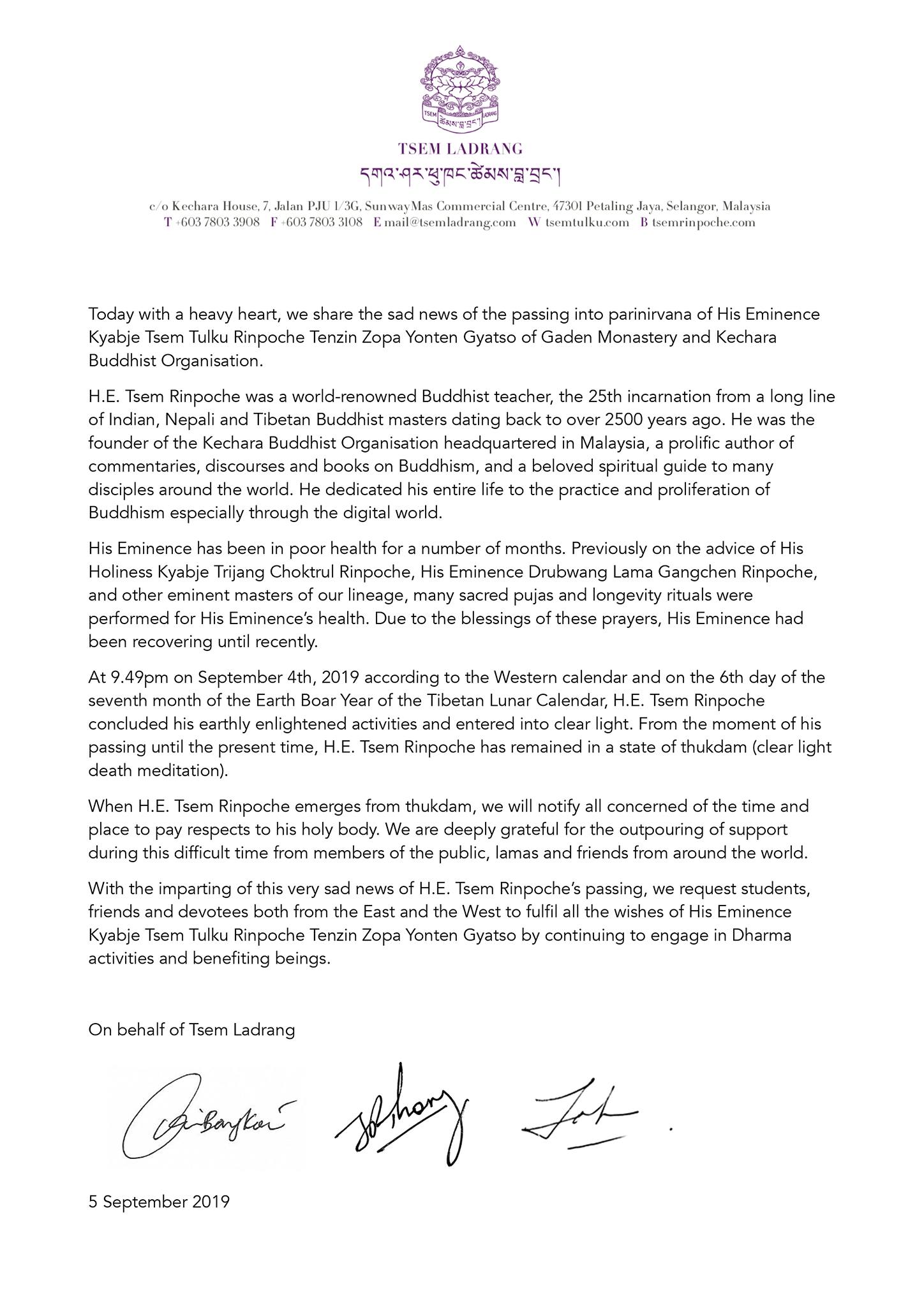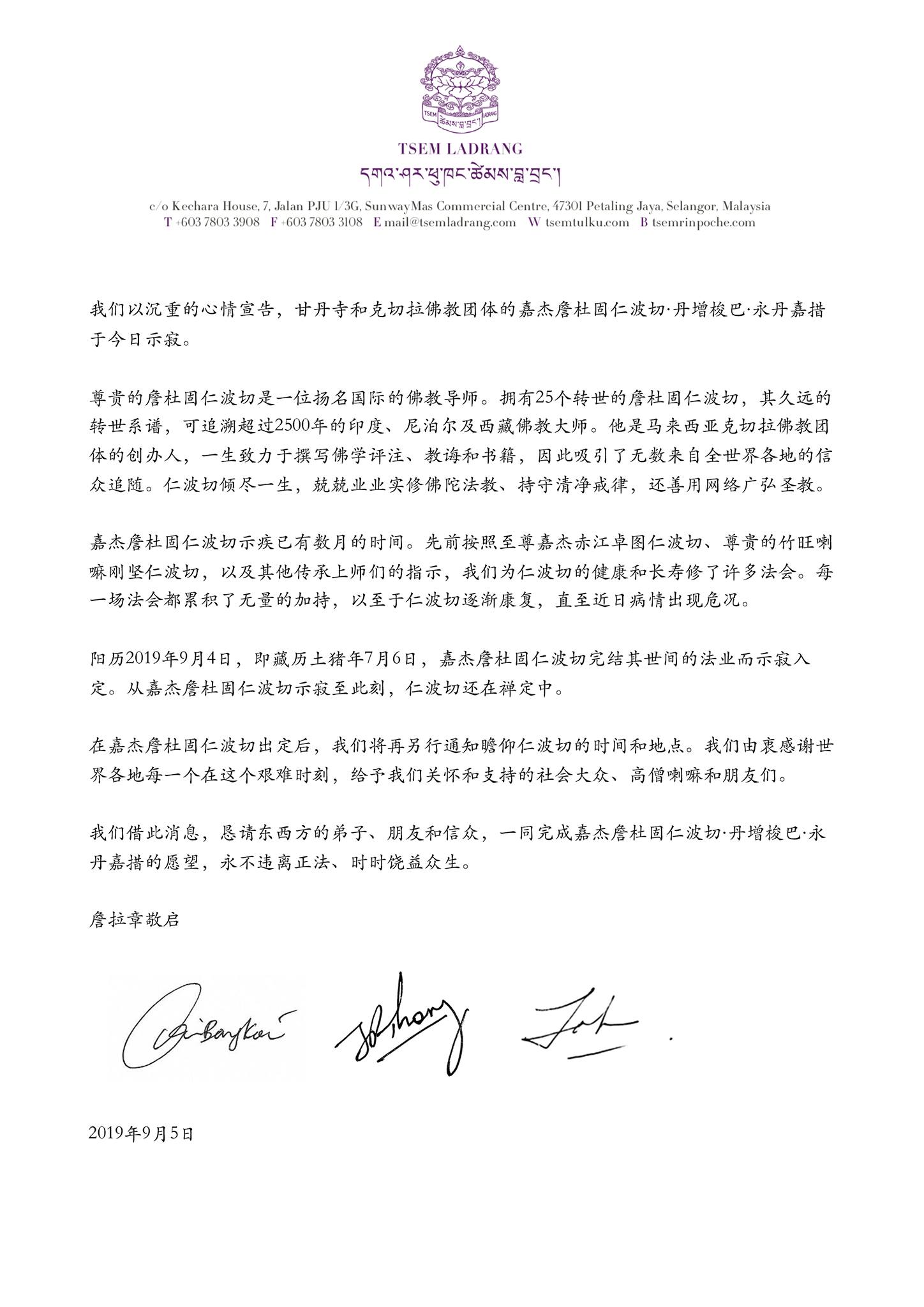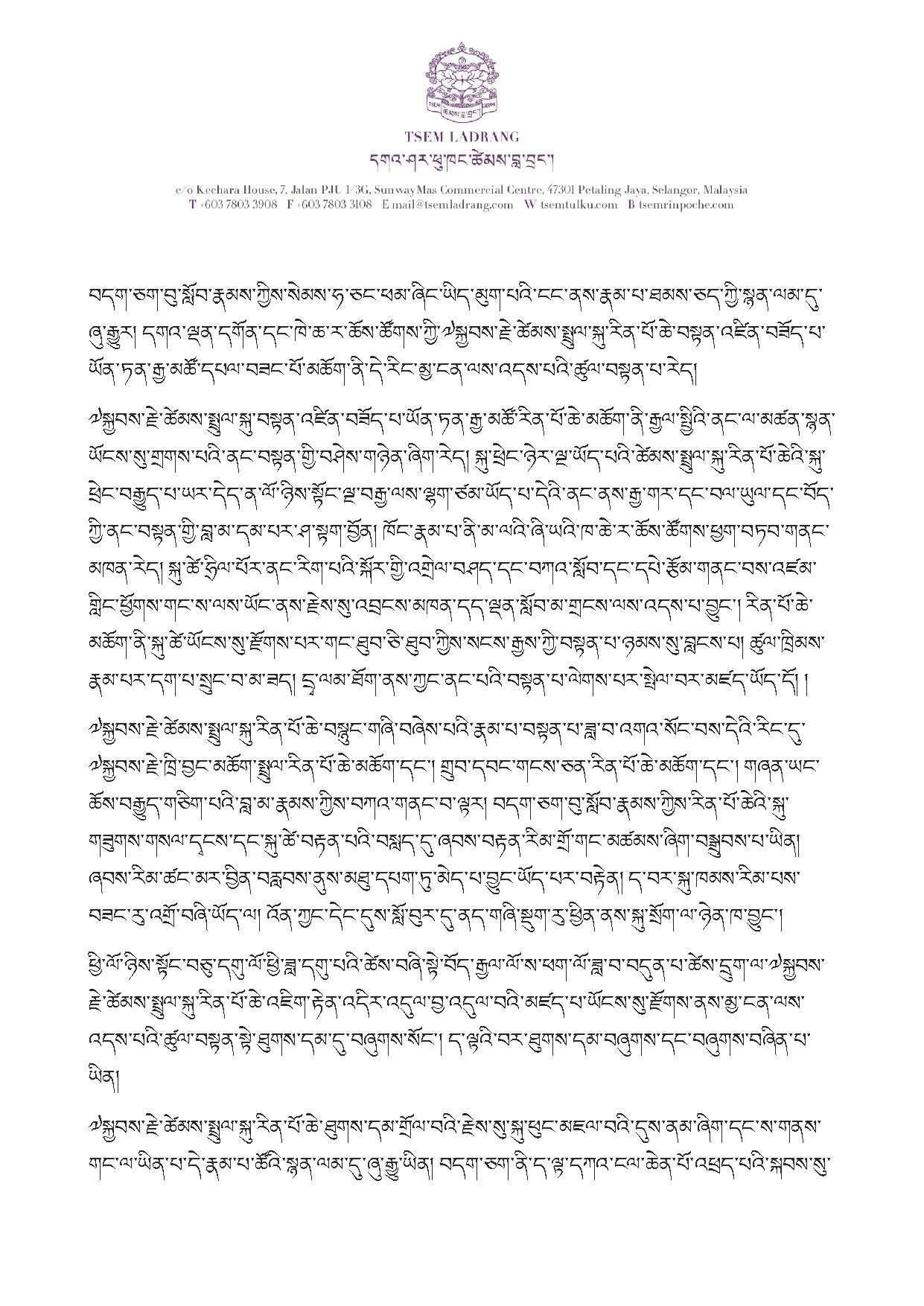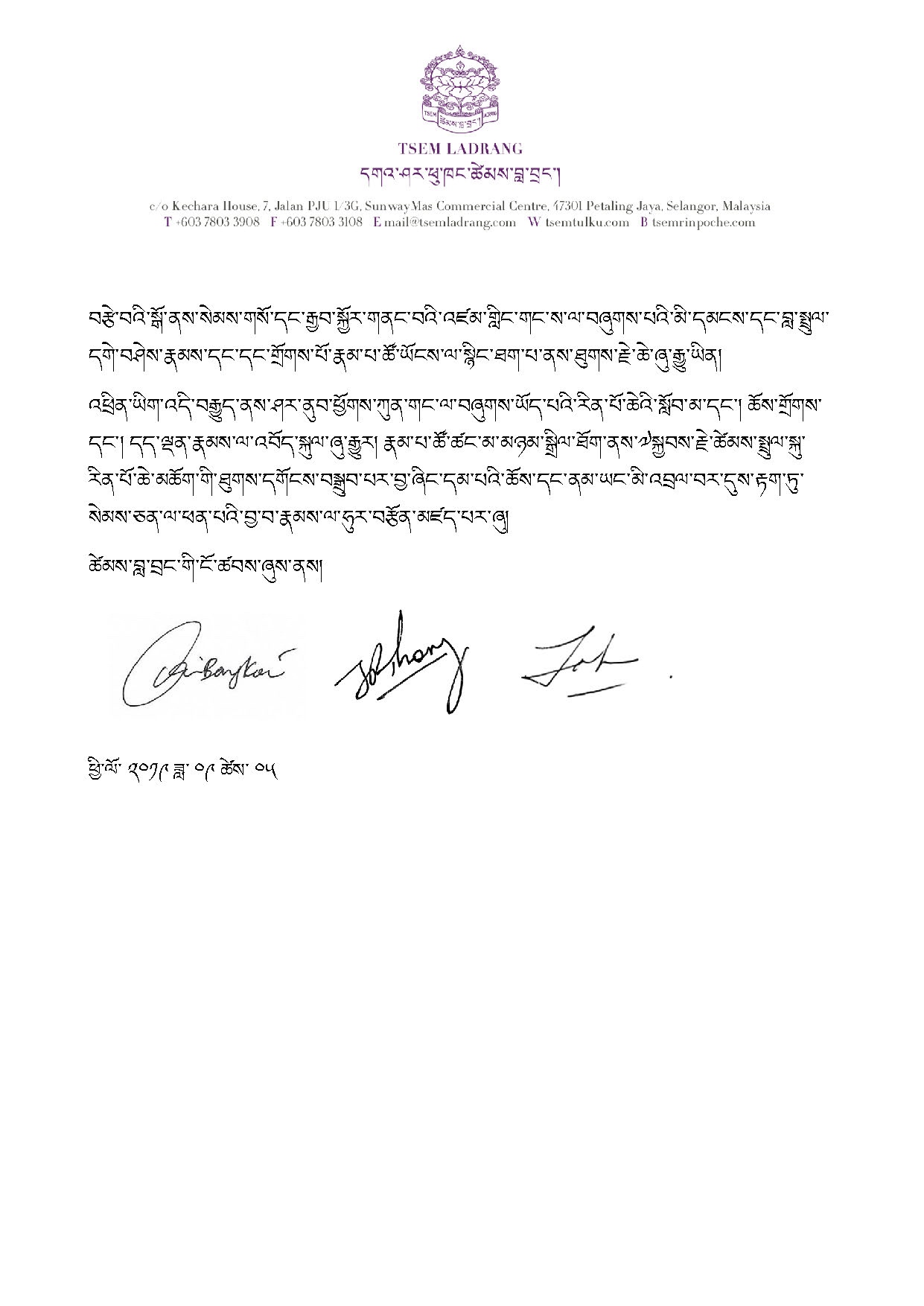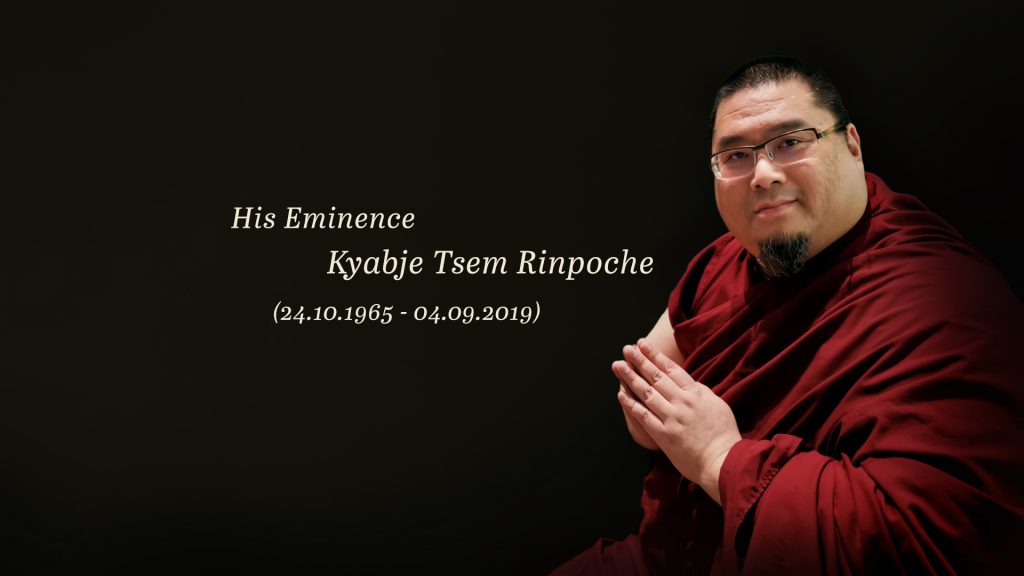Parinirvana
The Parinirvana of H.E. the 25th Tsem Rinpoche
Official Announcement
Words have power but sometimes they are just not enough. No obituary can articulate the profound sense of loss we feel at the passing of the great being and enlightened Guru, H.E. the 25th Tsem Rinpoche.
Everything Rinpoche did had a singular purpose: to ease the sufferings of others and gently shape their lives according to the Dharma. Many of us who have benefited from Rinpoche’s compassion now perceive a gaping emptiness in the part of our lives that he occupied.
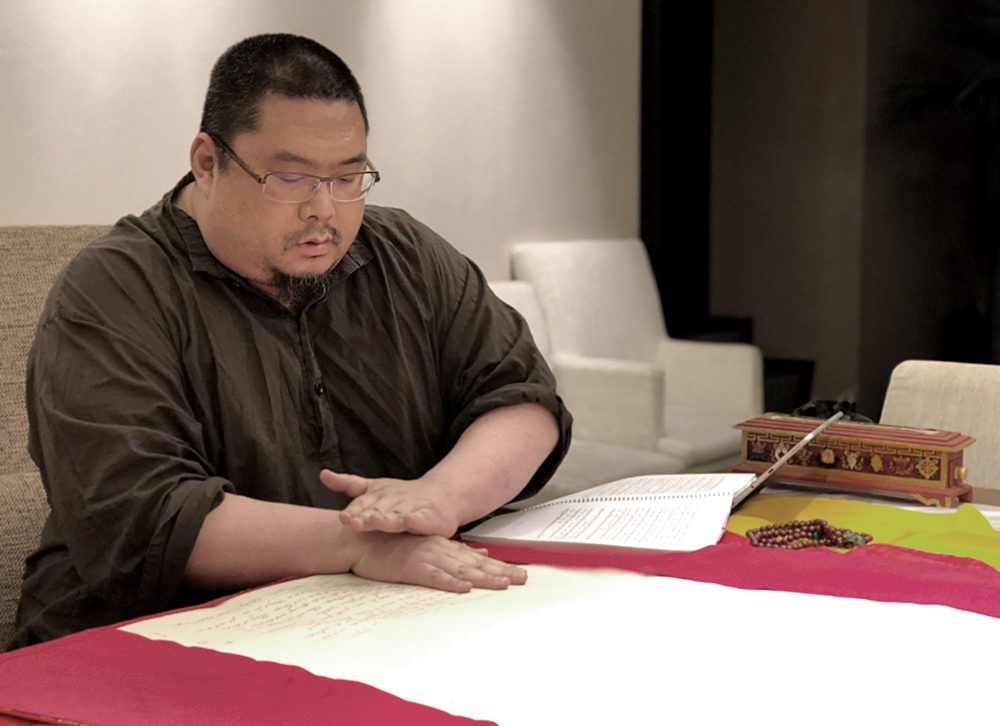
Yet, despite being recognised as a high incarnation, Rinpoche led a life largely bereft of the usual resplendence and spiritual majesty. This was a deliberate choice made by an enlightened being. Rinpoche had made the choice to be born lowly as an unwelcome child, a choice to be a teenager who had to overcome overwhelming odds to become an ordained monk, and a choice to be a young Rinpoche in a country that did not know how to serve a Dharma king properly.
It only follows that Rinpoche’s entry into parinirvana would seem similarly ‘ordinary’. The hallmarks of a true Buddha become clear, though, if we make a slight effort to look beyond the surface.
On one hand, Rinpoche’s passing was sudden and unexpected, leading some to assume that his ailments stemmed from the physical form that he manifested in. In reality, Rinpoche was extremely healthy, living a simple life free of all intoxicants and eating only small portions of food, and his last comprehensive medical check-up had cleared him of all ill-health.
On the other hand, those more well-informed about the ways of Buddhas know that enlightened beings are in complete control of all dimensions of their lives. This includes the physical state of their worldly bodies (the nirmanakaya body), the time and place of their birth, and the time and circumstance of their passing.
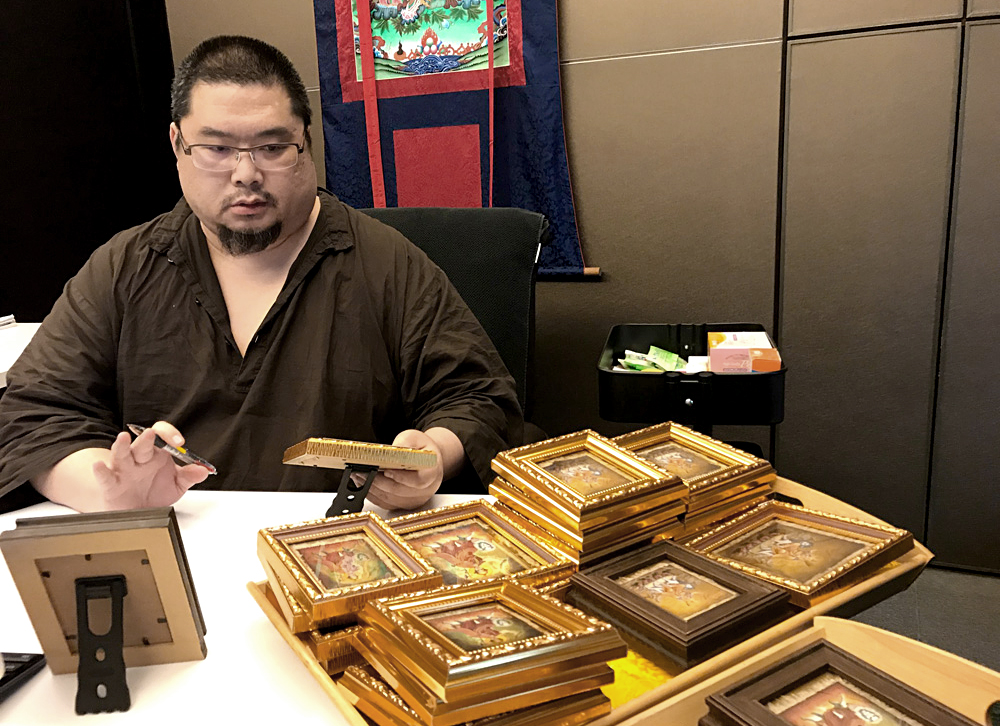
Enlightened beings appear in samsara for very specific reasons. Rinpoche had stated on many occasions that the purpose of his 25th incarnation was to uphold the purity of Lama Tsongkhapa’s lineage, to shield it at a time when it would come under assault, and to remove obstacles that threatened the sanctity of this sacred lineage.
Ultimately, that purpose necessitated Rinpoche to absorb the obstacles and thereby remove them, as he left his worldly body under complete control.
Rinpoche had hinted on a number of occasions, even during public teachings, that his 25th incarnation would not remain long in our world. One such instance was in 2015, when the Venerable 7th Panglung Kuten took trance of the Dharma Protector Dorje Shugden in Kechara Forest Retreat for the first time. To perhaps the biggest live audience to have listened to him speak in person, Rinpoche said that in a few short years, he would no longer be around.
That statement was probably taken to be a general reminder to use our precious human lives meaningfully, just as the Lamrim counsels. However, it was one of the clearest indications that the sacred mission of the 25th Tsem Rinpoche would soon reach its fulfilment.
A Divine Plan
Tsem Rinpoche was known for his great compassion, tremendous generosity and extraordinary thoughtfulness. Rinpoche was considerate to such a degree that he would pay attention to even the smallest details that could make a person’s life better.
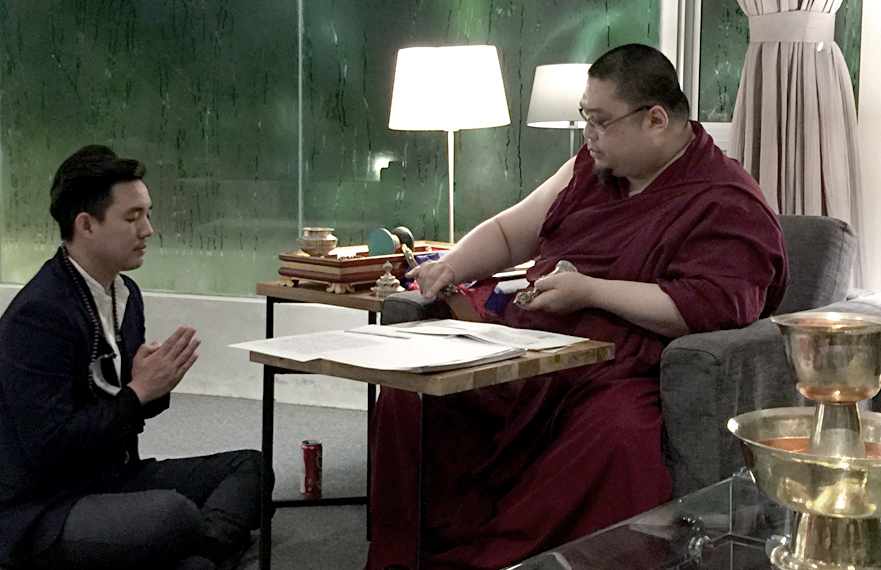
We saw this aspect of Rinpoche in the way he served his teachers such as H.E. Kensur Jampa Yeshe Rinpoche, ultimately offering up his own house so that the elder lama could have his own ladrang. We saw it again when Rinpoche protected the lineage of Dorje Shugden, sparing no effort in correcting misperceptions about this Dharma Protector practice, even at the cost of his own welfare and reputation.
Even Rinpoche’s care for his students was legendary. Everyone who came into contact with Rinpoche received not only Dharma teachings, blessings and prayers but also gifts. Somehow, Rinpoche would know what a person needed most at the time, be it money, medicine, transportation or just a friend to hug.
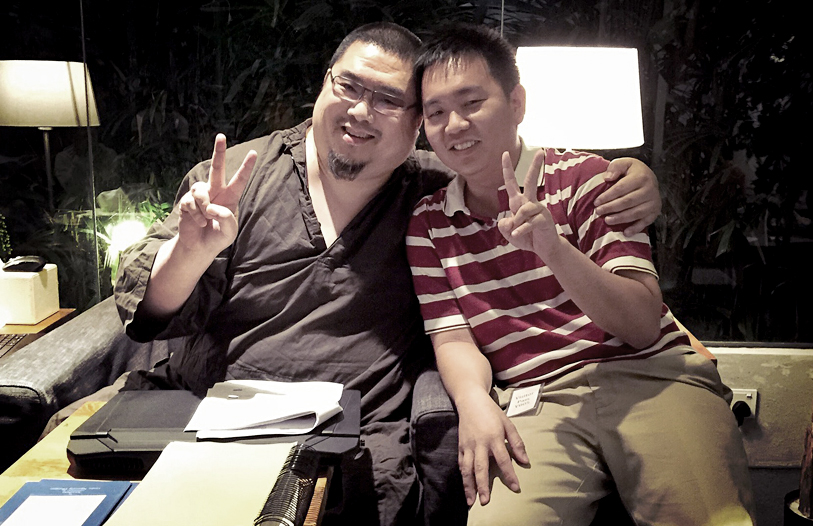
And so, it would be uncharacteristic of Rinpoche to leave this world before making sure that his students, Kechara and all who depended on him were on good footing. In hindsight, it was clear that Rinpoche had prepared very well for his entry into parinirvana. The high lamas and monks who later came to Kechara Forest Retreat said the same thing.
A few years ago, Rinpoche began giving away most of his belongings including personal statues and precious holy objects. In Tibetan culture, this is a subtle signal that the lama will soon enter clear light, as he should depart the world just as he came into it, without possessions, leaving only a living legacy.
A few months before he manifested illness, Rinpoche gave precise instructions for the office area in Tsem Ladrang to be cleared out. At the time, this move seemed arbitrary because it didn’t make sense to empty out one section of the working area to overcrowd another.
Only after Rinpoche’s passing did we come to realise that Rinpoche had anticipated where his kudung (holy body) would be enshrined, and had created room for visitors, friends and students to commiserate during the wake as they awaited their audience with Rinpoche’s kudung.
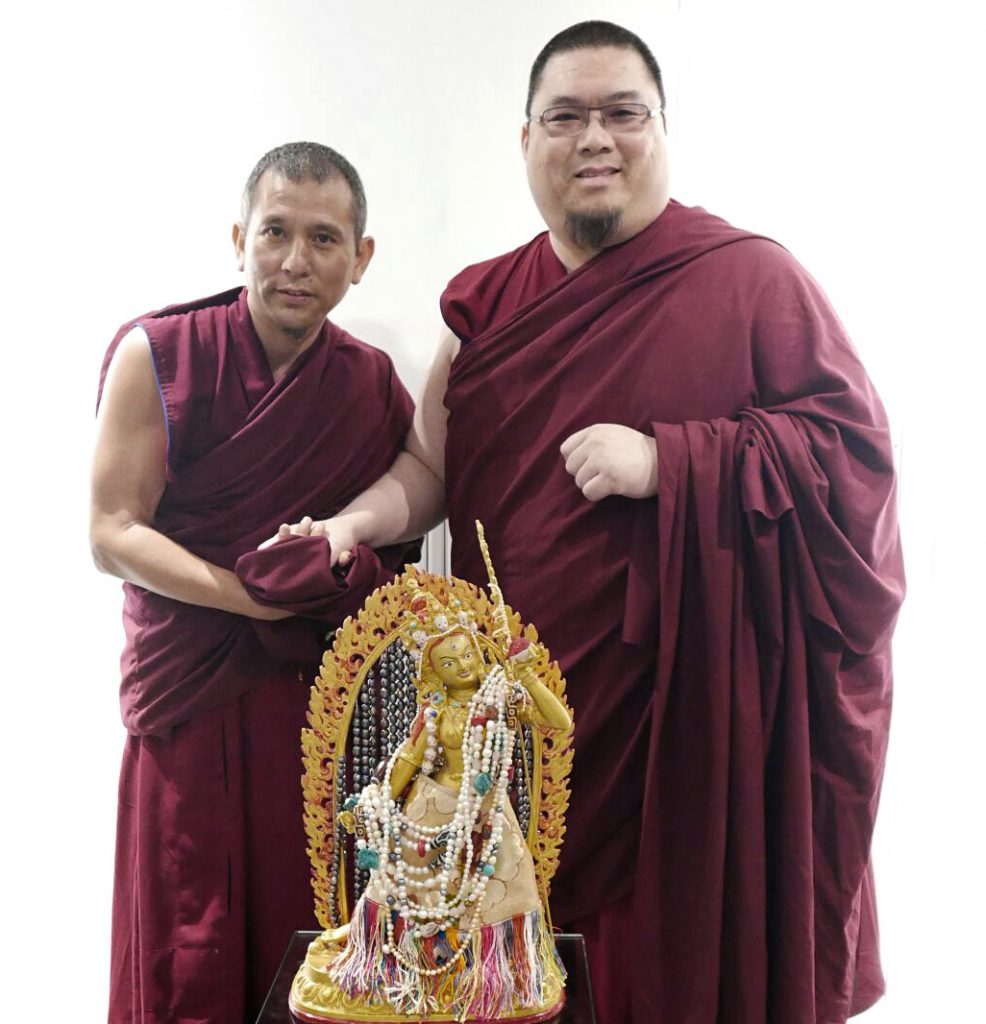
Entire sections of Dukkar Apartments were similarly depopulated, which made it easy when the time came to prepare accommodation for visiting high lamas and monks whom Rinpoche knew would come to offer prayers and pay respects. Rinpoche had also met with his changtsos to ensure that all administrative matters were in order.
Even the ground which was chosen for the funeral ceremony and Rinpoche’s outdoor relic stupa was commissioned by Rinpoche as early as September 2015.
These events and many similar ones are either a series of coincidences or the signs of a clairvoyant lama making provisions for his parinirvana. The latter is coherent with Rinpoche’s nature of taking onto himself as much as he possibly could without burdening others.
It was only after Rinpoche was satisfied that everything was in order that he manifested sudden illness. Then, following the path of the Buddhas and the great beings who came before him, Rinpoche began a slow march towards his own departure, with each step opening up vast opportunities and creating the stimulus for students and Dharma practitioners to engage in highly meritorious acts.
Turning Point
In July 2019, Rinpoche received news that His Holiness Kyabje Trijang Chocktrul Rinpoche was planning to confer a life entrustment initiation (sogtae) of Dorje Shugden. Upon hearing this news, Rinpoche’s face lit up with sheer joy. It was the sign that Rinpoche had long been waiting for, an indication that the time had come for His Holiness to rise and fully manifest the deeds of his previous lives.
Rinpoche immediately dispensed instructions to make a series of offerings to His Holiness and to sponsor the food that would be served during the ceremony. In the days that followed, Rinpoche often asked if a public announcement of the event had been made. As the days stretched into weeks and no further news was forthcoming, Rinpoche manifested the first indications of being unwell.
Although the initial symptoms did not signal any life-threatening diseases, various physicians were consulted and medications were prescribed. There were interim signs of improvement but the symptoms persisted.
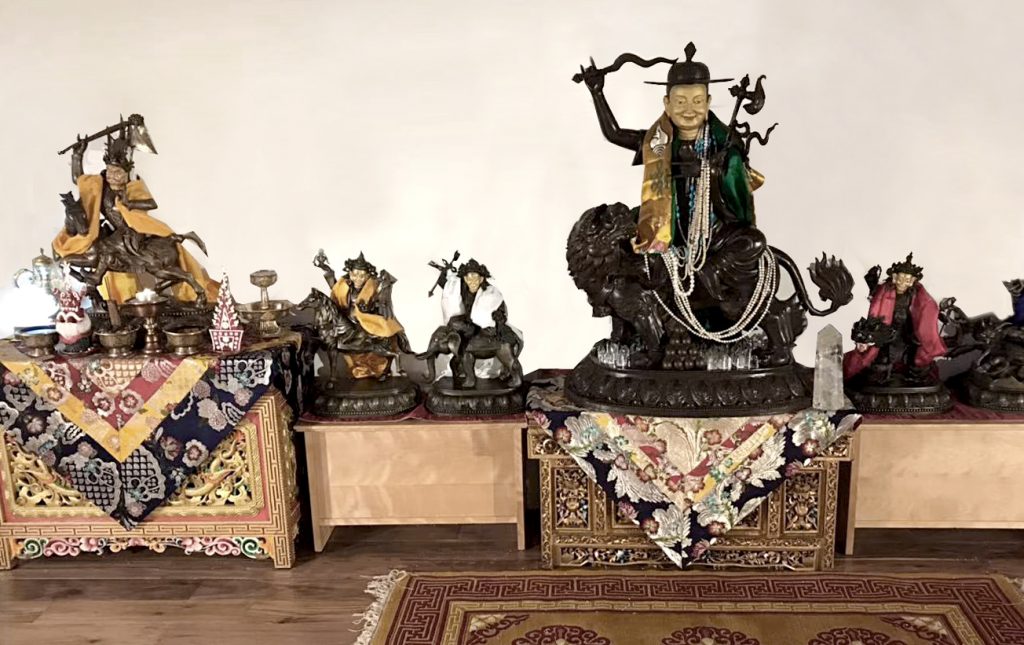
For the most part, everything went on regularly as it had for years at Tsem Ladrang. Rinpoche was working at the usual hectic pace, meeting students, giving teachings and overseeing various Dharma works while creating as much joy as one would find in a happy home.
However, by August 2019, it was clear that the increasing pain was exacting a toll on Rinpoche. Despite becoming physically weaker, Rinpoche worked right up until his hospitalisation, driven by sheer will and firm determination to create as much benefit as possible.
Rinpoche had his final meal in the Ladrang in the early hours of August 6th, 2019. At around 9 a.m., Rinpoche manifested acute pain. Shortly after, Rinpoche was rushed to a hospital in Kuala Lumpur.
Transcending Pain
To fully comprehend the depth of Rinpoche’s kindness, we must first try to grasp the tremendous suffering Rinpoche allowed his body to undergo. Rinpoche was hospitalised for an entire month, of which 29 days were spent in the intensive care unit (ICU).
In that time, Rinpoche was attended to by six different medical specialists, an indication of the severity of the multiple complications that Rinpoche manifested. Due to his critical condition, Rinpoche also underwent endless invasive procedures including intubation. This left Rinpoche unable to speak and barely able to move.
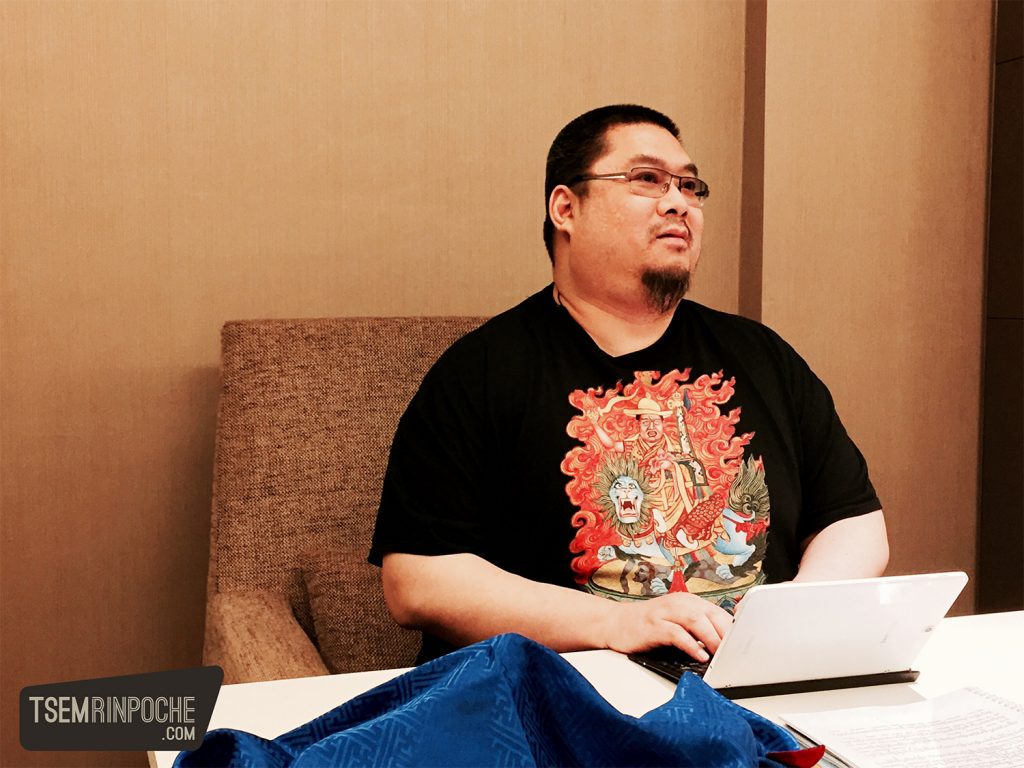 Still, not one to be defeated by circumstances, Rinpoche resorted to gentle hand gestures and silently mouthing words, and those attending to Rinpoche learned to guess what Rinpoche was trying to say. Often, it was to ask how a particular person was doing or to tell those in attendance to rest. Even in that critical state, Rinpoche’s thoughts were on the well-being of others.
Still, not one to be defeated by circumstances, Rinpoche resorted to gentle hand gestures and silently mouthing words, and those attending to Rinpoche learned to guess what Rinpoche was trying to say. Often, it was to ask how a particular person was doing or to tell those in attendance to rest. Even in that critical state, Rinpoche’s thoughts were on the well-being of others.
We may ask ourselves why an enlightened being in full control of his body would allow himself to undergo such prolonged physical suffering. In this question itself, we get another insight into the vastness of Rinpoche’s compassion. Each day Rinpoche shouldered the immense pain was another day of opportunity for students and well-wishers to generate tremendous merits for themselves. It is highly meritorious for devotees to petition an enlightened being to remain, to supplicate a guru to live long, and to finally realise the urgency of tearing themselves away from samsaric distractions.
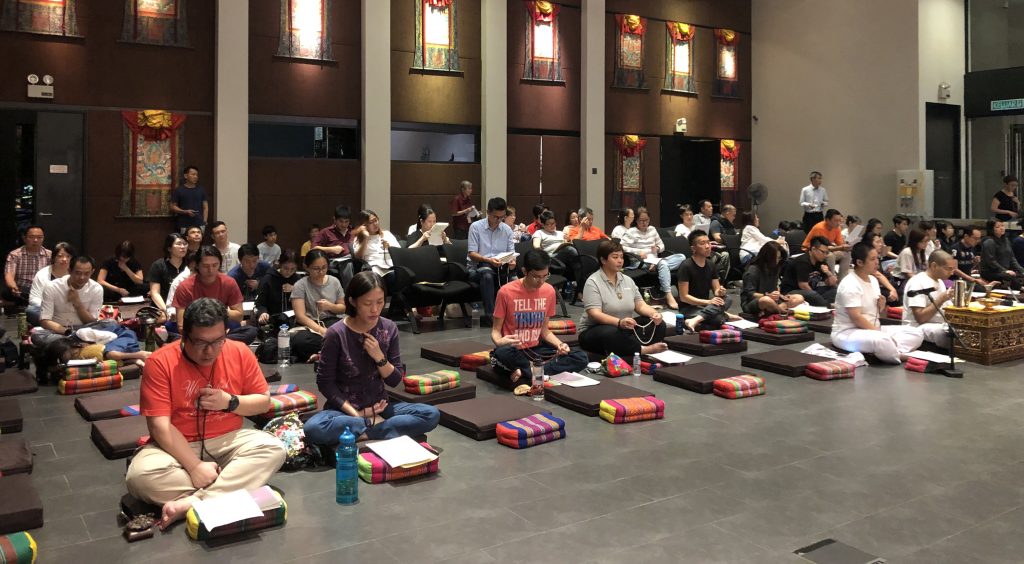
Coming Together
Rinpoche’s failing health gathered old friends and new followers, reunited members who had become estranged for myriad reasons, marshalled the devotion of students and inspired them to new levels of piety, and rallied a host of high lamas to Kechara.
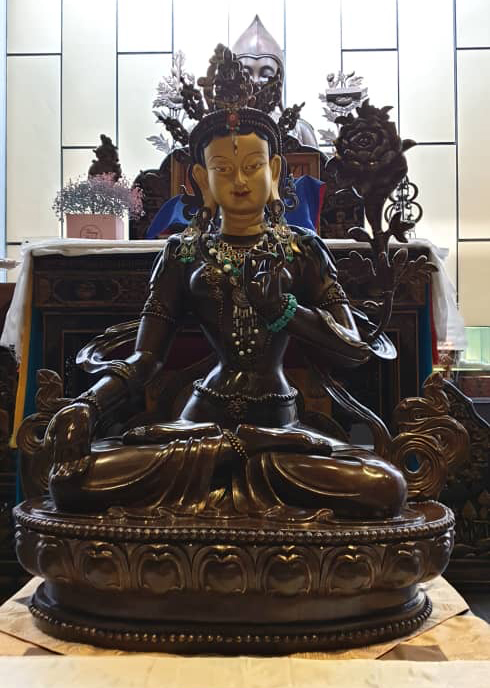
The outpouring of support from notable lamas was instant. His Holiness Kyabje Pabongka Chocktrul Rinpoche, His Holiness Drigung Kyabgön Rinpoche, His Eminence Drubwang Gangchen Rinpoche and Ven. Zawa Tulku Rinpoche offered guidance, pujas and prayers. Monasteries and Dharma communities around the world conducted pujas and held prayer vigils requesting Rinpoche to remain. Most pivotal of all, His Holiness Kyabje Trijang Chocktrul Rinpoche and the Dharma Protector Dorje Shugden (invoked through the Venerable 7th Panglung Oracle) provided important advice and much spiritual support at every turn.
Students came together, pushing aside all interferences to their practice. They focused on prayers with pure motivation. They confessed mistakes and negligence of their spiritual commitments, engaged in purification practices, made offerings of body, speech and mind, and earnestly petitioned for an enlightened being to remain with us.
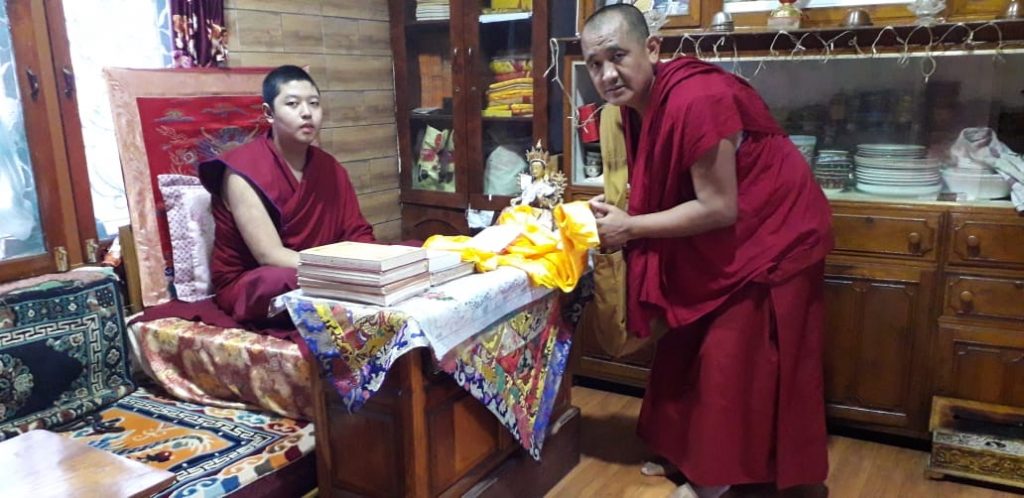
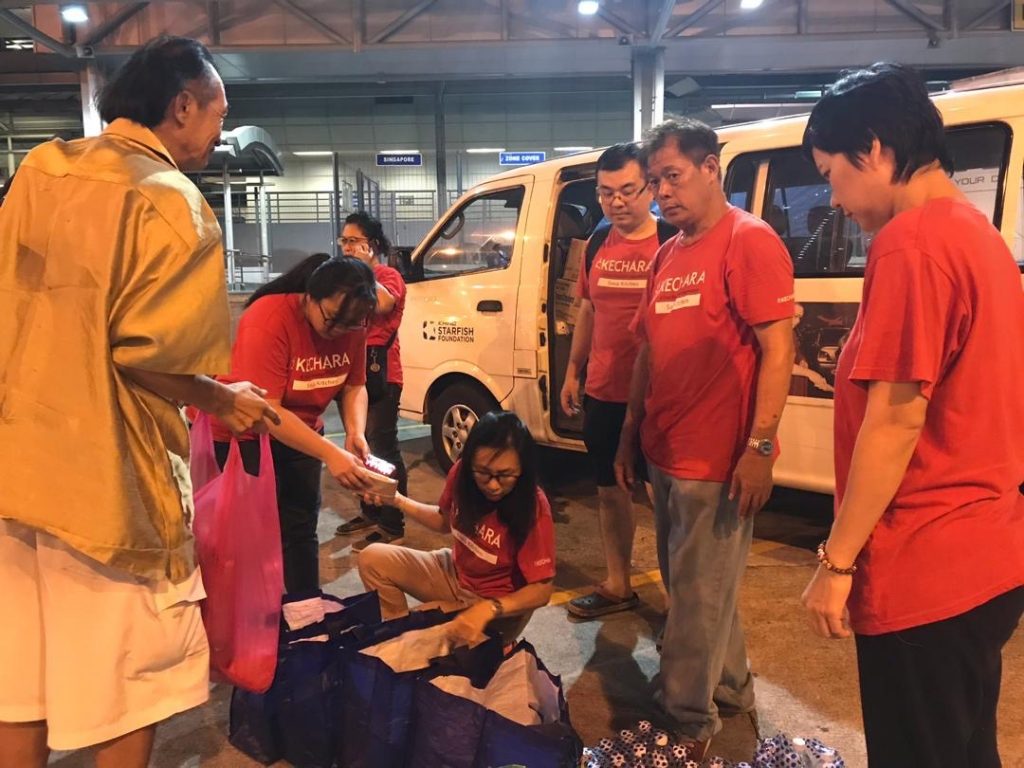
The process intensified their faith in the Dharma. It created an occasion for people to contemplate impermanence, to recognise the frailty of life and the foolishness of samsaric pursuits, and to strengthen their resolve to practise spirituality.
While costly to himself, Rinpoche’s suffering created the perfect conditions for Dharma to flourish.
A Glimmer of Hope
For three weeks, Rinpoche treaded a tightrope strained between life on one side and death on the other.
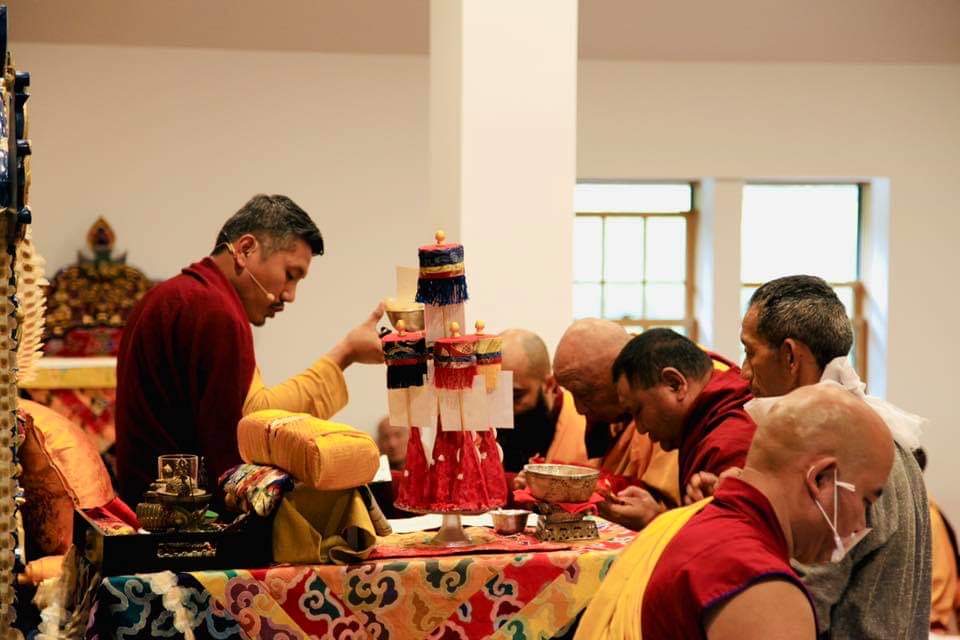
In mid August, we received the much anticipated news that the Dorje Shugden life entrustment initiation by H.H. Kyabje Trijang Chocktrul Rinpoche had been publicly announced. A few days later, Rinpoche’s condition stabilised. On 28th August, Rinpoche’s recovery allowed doctors to remove the ventilator tube. While still weak, Rinpoche was now able to speak again.
Rinpoche’s first words were not about himself. They were words of gratitude, care and encouragement for the doctors and nurses.
Rinpoche was even able to articulate in detail how some of the nurses behaved kindly towards him. They were surprised because Rinpoche had seemed to drift in and out of consciousness over the weeks from the strong sedation, and yet Rinpoche was fully aware of what had been happening around him.
Rinpoche also joked and teased the attending doctor and spoke to her encouragingly for about 45 minutes. This was a reversal of roles because it is normally the doctor who is expected to lift the spirits of a critically ill patient. But this was Tsem Rinpoche.
Then, Rinpoche pointed out some ways the hospital could ease the psychological stress on ICU patients. For instance, Rinpoche observed that there were no clocks in the ICU rooms. In a windowless room without a clock, little distinguishes one hour from the next. It is easy for a sense of dormancy to set in, stagnating hope. That hope can often tilt the delicate balance for seriously ill patients who are at risk of giving up due to sheer pain and exhaustion. Rinpoche wanted to ensure that ICU patients had everything they needed to keep hope buoyant.
Rinpoche asked the doctor how many clocks she would need for the ICU. She said 10. Rinpoche offered to sponsor 15 and immediately gave instructions for the clocks to be bought quickly, with batteries installed and wall hooks attached, ready to be mounted.
The ICU doctor later revealed that the 45-minute conversation with Rinpoche was a life-changing experience. She was a highly competent, passionate and dedicated doctor but the ICU, where death comes knocking almost daily, had left an indelible psychological impact. Rinpoche’s uplifting words empowered her already kind heart. Today, Rinpoche’s picture sits at the centre of the doctor’s shrine.
Then, Rinpoche spoke to a few close students and gave words of advice and some assignments, including instructions to convey a message to H.H. Kyabje Trijang Chocktrul Rinpoche. By the time Rinpoche had finished, he was exhausted and needed assistance to breathe properly. It would have been better for Rinpoche to rest before straining to have such lengthy dialogues with several people. But Rinpoche expressed a sense of urgency to speak, as though he knew that they would be his final set of instructions.
The Final Act
As the days stretched into September, Rinpoche manifested complications which baffled the doctors. Rinpoche had been steadily improving but there now seemed to be a reversal and they could not pinpoint the cause of the rapid deterioration.
At around this time, Rinpoche began displaying a different demeanour. There was no doubt that Rinpoche was still in tremendous physical pain. However, now the pain did not manifest as winces and grimaces. Instead Rinpoche was silent and his mind, impenetrable. It was as if the pain had no effect on Rinpoche’s mind. Instead, there were signs that Rinpoche was in a state of meditative bliss.
At 9.49 p.m. on the 4th of September 2019, having satisfied himself that he had fulfilled all the duties his 25th incarnation arose to do, Tsem Rinpoche ceased all the bodily functions of his nirmanakaya form and entered into thukdam.
Entering Thukdam
While Rinpoche made it a point to hide his spiritual calibre out of humility, his enlightened nature became evident upon his passing.
The body of an ordinary person becomes cold upon death. It takes only a few hours for rigor mortis to set in and for visible skin discolouration to occur. Decomposition soon follows.
However, Rinpoche was no ordinary person. Though declared clinically dead, Rinpoche’s consciousness remained in his physical body in the state of thukdam. This is a state of meditation practised during the period of death, where the Buddhist master’s consciousness abides in clear light, an indication of his high attainments.
Rinpoche was graceful in thukdam. While lying in meditation, Rinpoche’s posture was regal and poised, and his demeanour was blissful and relaxed. Rinpoche’s skin remained soft and taut, and his limbs were flexible. There was a glow on Rinpoche’s face and the tremendous presence that he exuded in life remained.
For two days, Rinpoche’s body remained palpably warm, especially at the heart. Even the doctors who were not familiar with the Tibetan Buddhist concept of death meditation noticed it and were amazed.
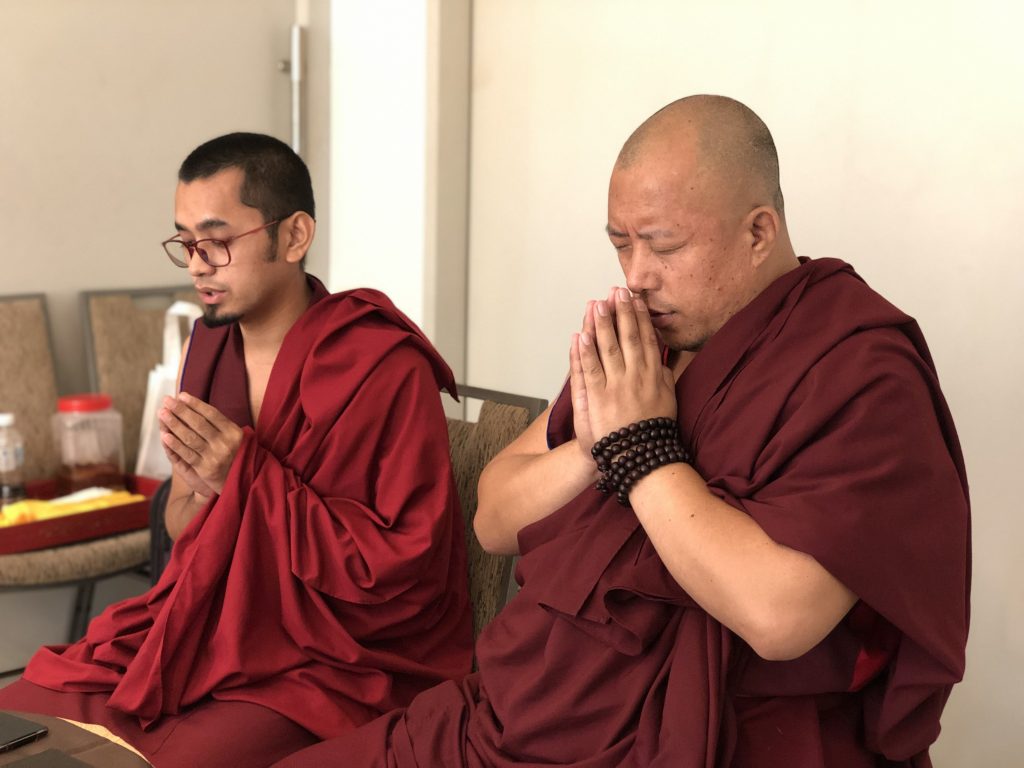
In the meantime, students of Tsem Ladrang and attending monks immediately commenced prayers beside Rinpoche’s holy body. In Kechara as well as in monasteries and Dharma centres in India, Nepal, Tibet, Europe and the United States, ordinary people and learned monks began chanting traditional prayers to generate merits for Rinpoche’s swift return.
When a high lama is in thukdam, care is taken that his holy body is undisturbed so as not to disrupt his meditation. This continues until the lama displays his emergence from meditation by manifesting a drop of blood from the nose and from the secret organ. And so, Rinpoche’s holy body was carefully covered with his chögo and attendants kept vigil as prayers were recited softly around the clock.
On the afternoon of 6th September 2019, Rinpoche signalled his emergence from thukdam. This was the final sign that Rinpoche’s enlightened consciousness had left his nirmanakaya form and that his parinirvana was complete.
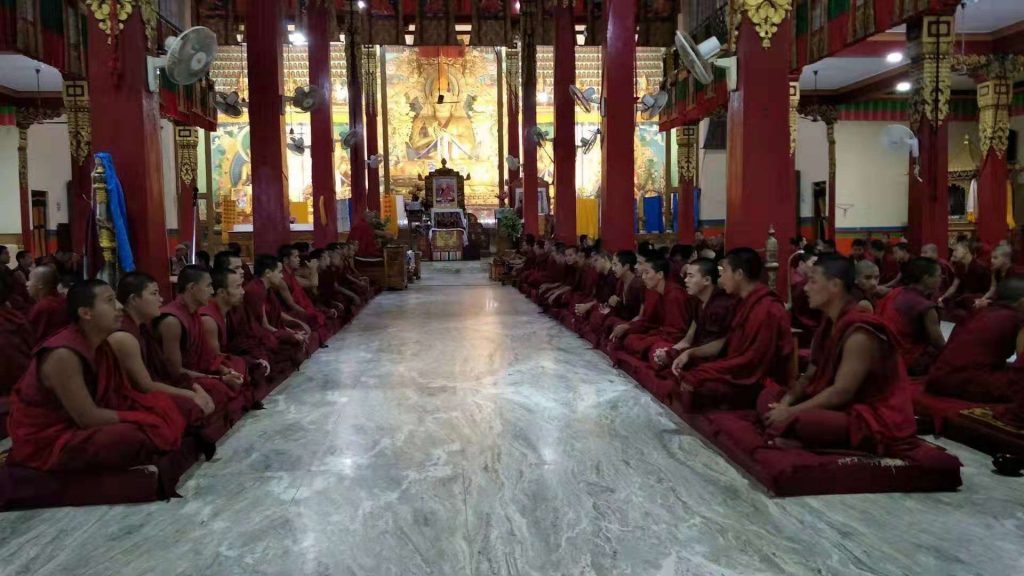
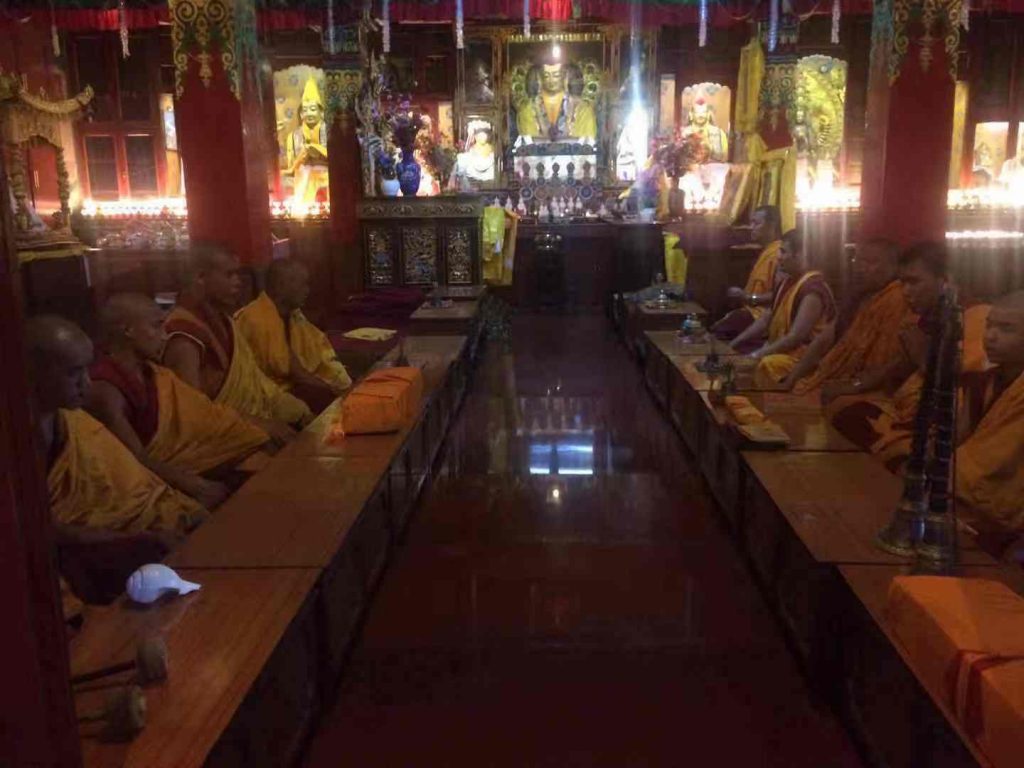
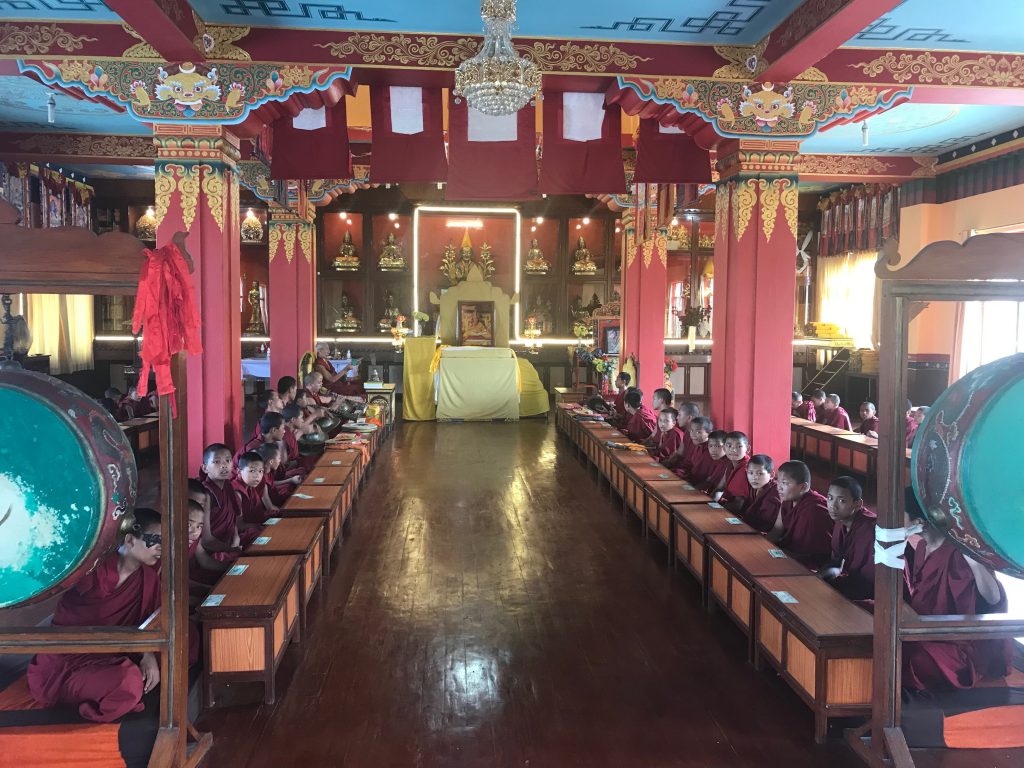
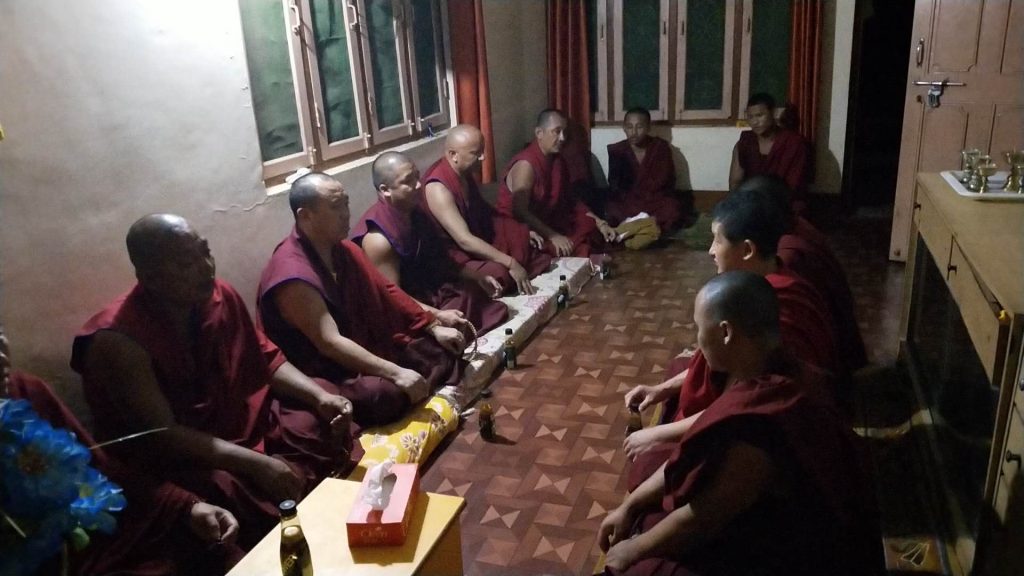
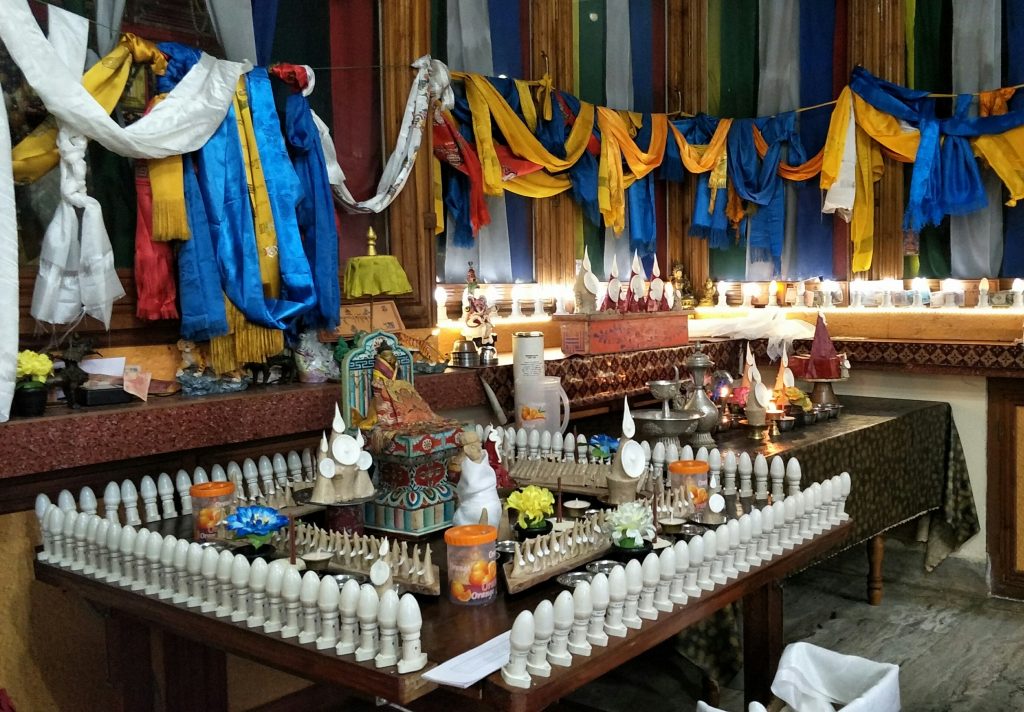
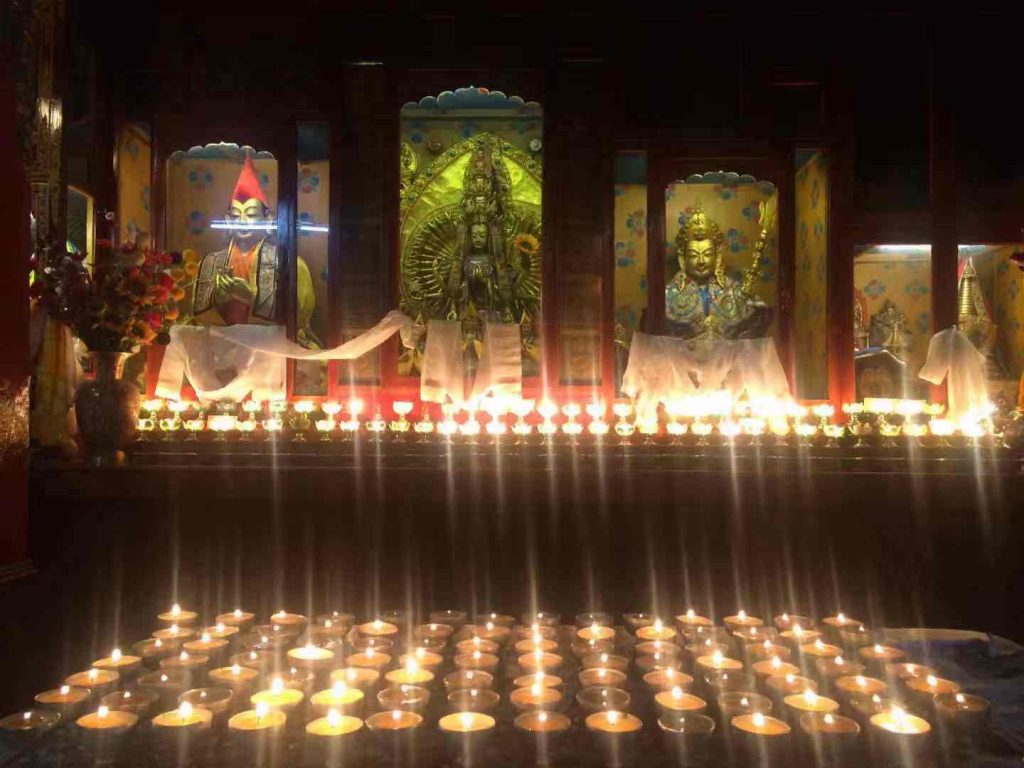
Return to Kechara
Out of tremendous consideration and to ensure that his students were not left on unfamiliar terrain, Rinpoche had with great love, furnished guidelines on what was to be done after his parinirvana. These included what pujas were to be performed and by which monasteries, instructions related to Rinpoche’s kudung, whom to consult during the search for his reincarnation, how to raise the young incarnation and many more directions of a similar vein. These guidelines had been given by Rinpoche personally in the years leading up to his parinirvana. Because of that foresight, Rinpoche’s students were able to accord Rinpoche’s kudung the proper and traditional accession now that the time had come.
Preparations began in earnest to escort Rinpoche’s kudung back to Kechara Forest Retreat. Assisted by Rinpoche’s attendants, the monks attended to Rinpoche’s kudung according to monastic traditions, including the ritual washing with special substances.
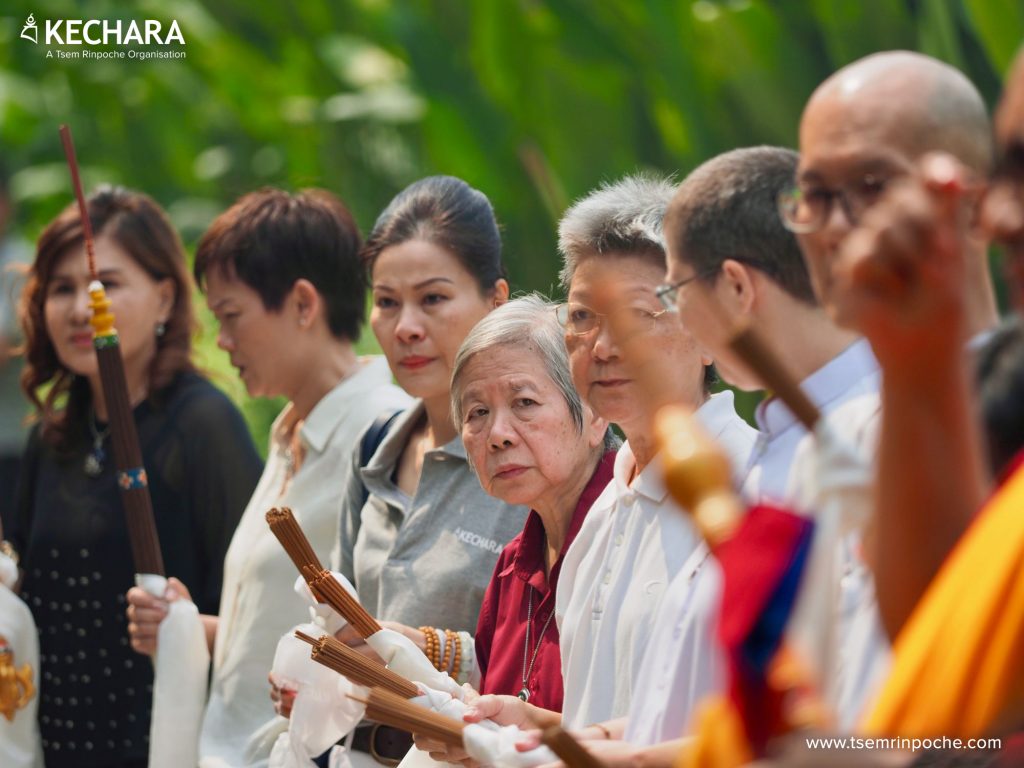
Click on image to enlarge.
By now, news of Rinpoche’s parinirvana had spread and Kechara Forest Retreat was teeming with people. High lamas, geshes and monks came from afar, old students returned from all corners of the world, and many people who had witnessed the magnitude of Rinpoche’s work came in droves to be part of a very important spiritual phenomenon.
On the afternoon of 8th September 2019, Rinpoche’s kudung was escorted back to Kechara Forest Retreat. In the middle of a convoy of vehicles driven by Rinpoche’s close students was Rinpoche’s carriage, adorned inside and outside with silks, brocades, ribbons, flowers as well as a host of offerings. Inside, an attendant offered billowing incense while reciting the Lama Chöpa.
Rinpoche’s kudung arrived at Kechara Forest Retreat at approximately 5 p.m. From the gates, monks, sponsors, students and friends, holding incense, flowers and khatas, lined the path leading to the Ladrang. A slow and sombre parade escorted Rinpoche home. Sadness was undeniably in the air and yet there was a certain dignity and majesty that usually accompanies the victorious march of kings and nobility, not corteges.
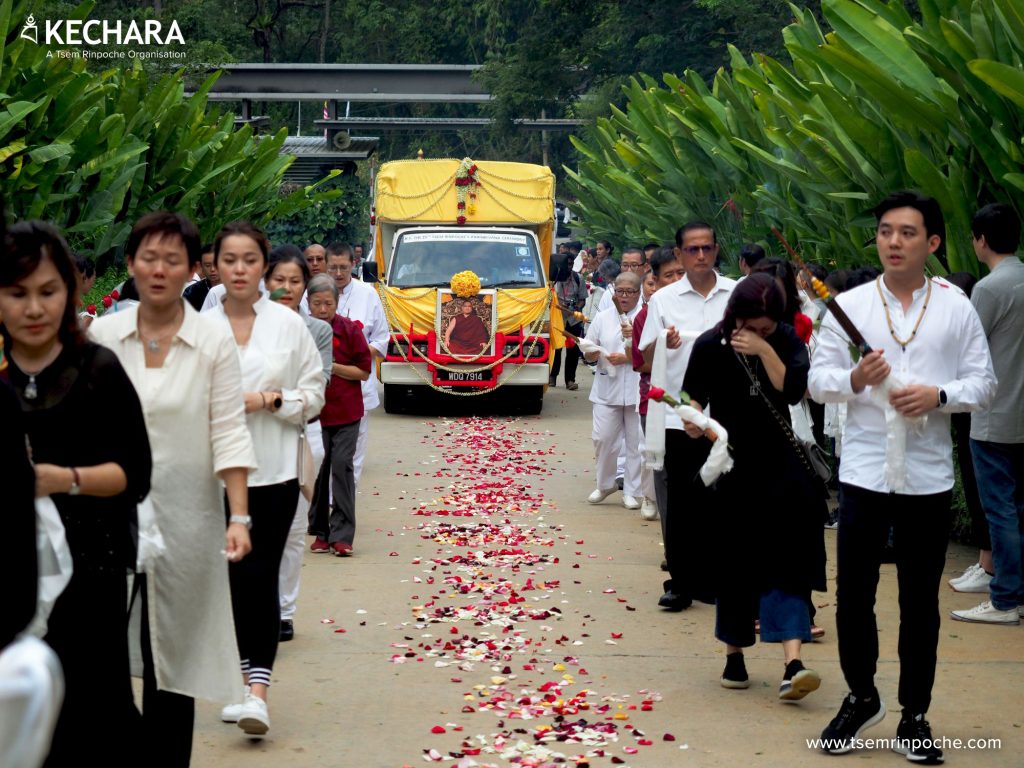
The Wake
Kechara Forest Retreat thronged with mourners. It was a clear indication of how beneficent Rinpoche’s life had been, how profoundly his teachings and Dharma activities had touched lives, and how well he had upheld Lama Tsongkhapa’s lineage.
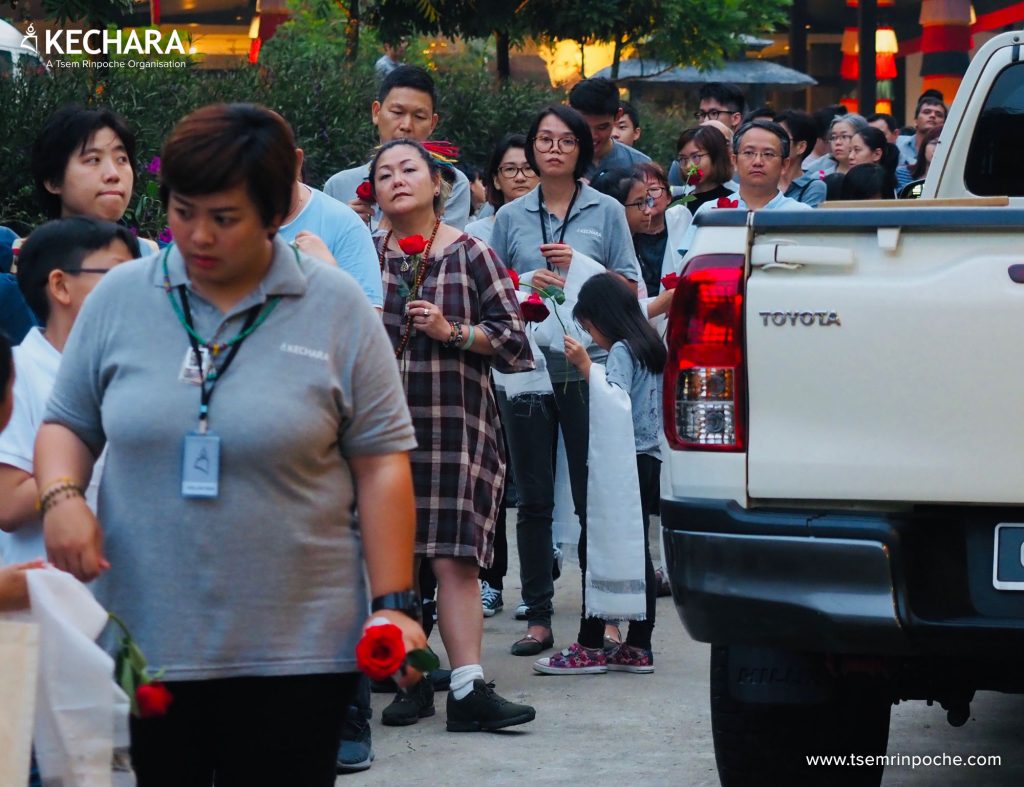
Click on image to enlarge.
Over the course of three decades, Rinpoche had single-handedly built a monastic outpost on a land not known for its practice of Vajrayana, nurtured a school of practitioners, and painstakingly shaped Kechara into a nerve centre of Lama Tsongkhapa and Dorje Shugden’s lineage.
It was a nigh impossible mission and this prodigiousness was not lost on the lamas, geshes and monks who came to bid Rinpoche farewell and to support Kechara in its time of need. For some, it was to finally have an audience with an esteemed lama whose great works they had witnessed. For others, it was a reunion with an old friend whom they had not seen since Rinpoche left his beloved monastery to bring Dharma to uncharted territory.
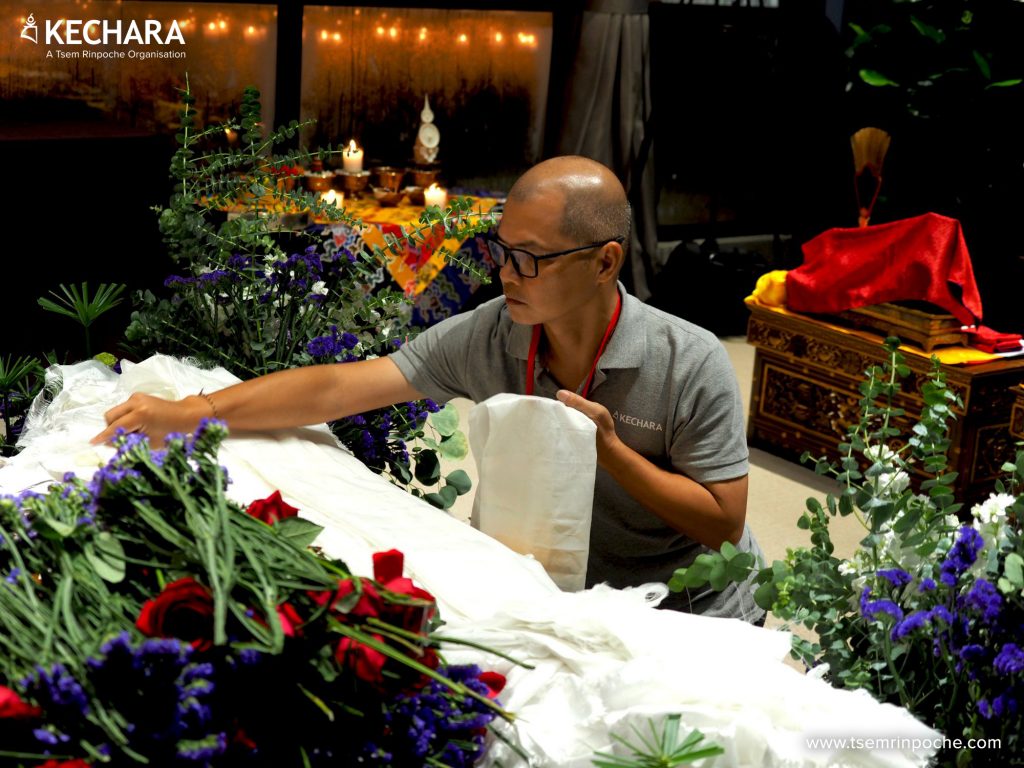
Rinpoche’s wake stretched to almost three weeks as Buddhist luminaries made their way to Kechara Forest Retreat to present offerings and prayers. The monks who came from Shar Gaden, Serpom, Phelgyeling and Segyued monasteries, and the representatives from Trisur Ladrang and Gangchen Ladrang were vital in the rituals pertaining to Rinpoche’s parinirvana.
The erudite Ven. Geshe Jangchup Gyaltsen from Italy, Shar Gaden’s Chantmaster Emeritus Gen Usula Lobsang Jinpa, and the acting Abbot of Phelgyeling Monastery, Gen Lobsang Palden were instrumental in advising on all aspects of the ceremonial preparations. Ven. Zawa Tulku Rinpoche who has always been a close friend of Kechara came from Canada to help and stayed till the very end. The Ven. Gameng Oracle and Lama Thubten Phurbu made the long journey from USA and China to pay their respects. Chojila, the Ven. 7th Panglung Oracle, arrived from Taiwan just two days after Rinpoche’s parinirvana and provided invaluable guidance and support throughout the traditional 49-day period. The grand Abbot Emeritus of Shar Gaden Monastery, His Eminence Kensur Rinpoche Lobsang Phende, came in spite of his advancing years and busy schedule to perform the fire offering ceremony and to preside over all rituals.
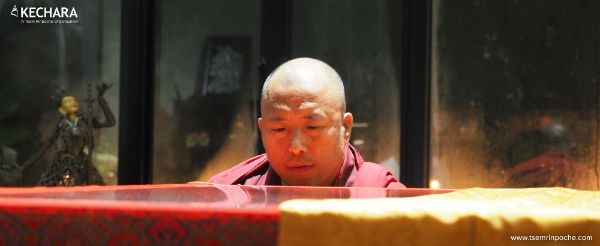
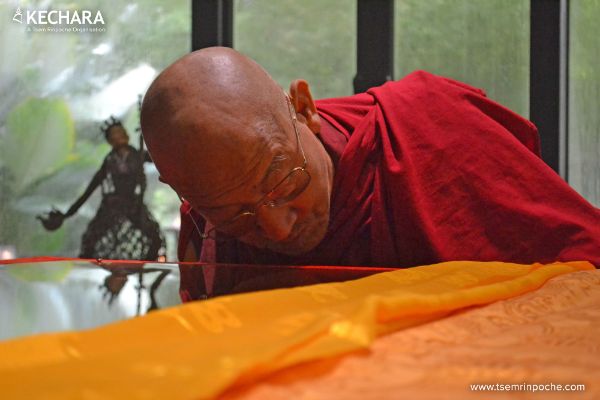
The wake was not merely a Tibetan affair by far. Rinpoche’s works were also well recognised in Malaysia. Leading Theravadan monks including Ven. Datuk K. Sri Dhammaratana Nayaka Maha Thero – the Chief Sangha Nayaka (Chief High Priest) of Malaysia, and Ven. B. Sri Saranankara Nayaka Maha Thero – the Adhikarana Sangha Nayaka (Chief Judiciary Monk) of Malaysia came to offer prayers and to have an audience with Rinpoche’s kudung. Similarly, government officials came to pay their respects and to recognise Rinpoche’s contribution to the nation of Malaysia and her people.
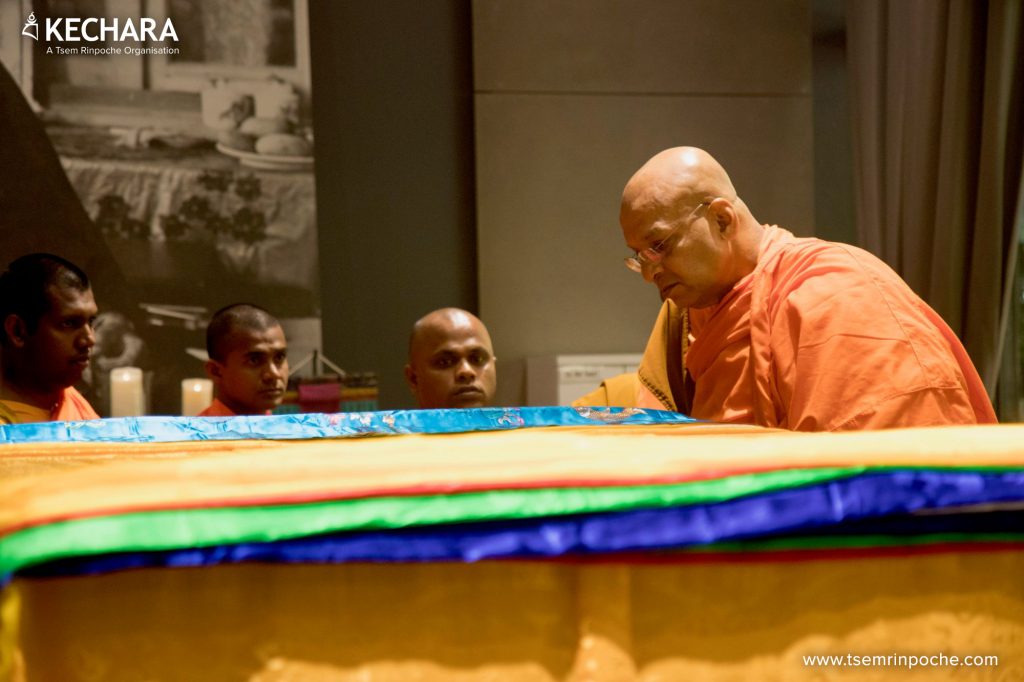
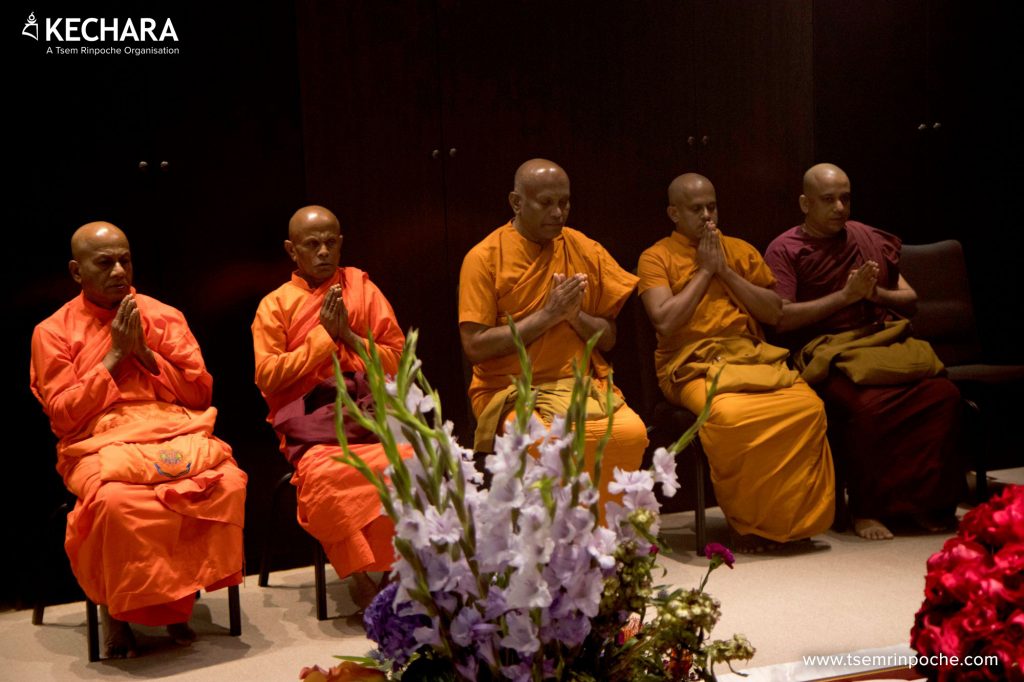
Blessed Activities
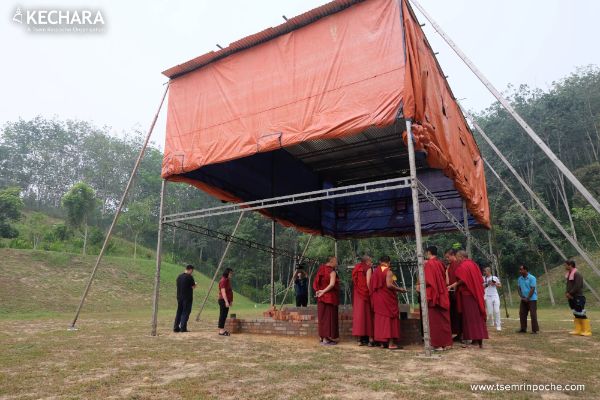
In the meantime, work was underway in an erstwhile vacant plot of land that Rinpoche had prepared five years ago. At the centre stood the Stupa of the Holy Body – a traditional funerary stupa or bul-khang – that took form very quickly, representing the sacred mandala of a holy being. The surrounds were beautifully ornamented with symbols of auspiciousness, long flowing silks, brocades, victory banners and Rinpoche’s favourite flowers.
The high lamas composed beautiful swift return prayers, deep in meaning and moist with reverence. The luminaries who wrote prayers to supplicate Rinpoche to return swiftly were H.H. Kyabje Trijang Chocktrul Rinpoche, H.E. Drubwang Gangchen Rinpoche, H.E. Kyabje Zemey Chocktrul Rinpoche, H.E. Lama Thubten Phurbu Rinpoche, H.E. Anor Tulku Ngawang Lobsang Choekyi Gyaltsen, H.E. Khen Rinpoche Jhampa Khetsun of Serpom Monastery, Venerable Geshe Tsultrim Tenzin and Venerable Geshe Lobsang Choedar.
At the request of Lama Gangchen Rinpoche, Lama Thubten Phurbu also composed a Guru Yoga Practice of Tsem Rinpoche — a complete seven-limb prayer recognising Rinpoche as being one in nature with Heruka, and the embodiment of all refuge.
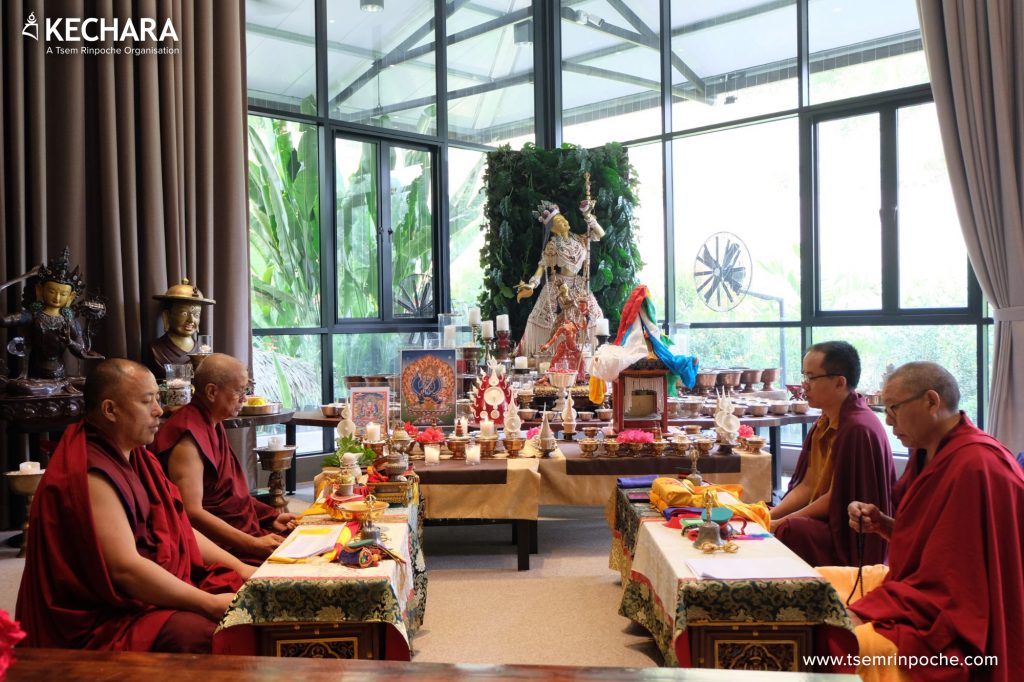
And so, while this period was underscored by grief and mourning, it was also a tremendous celebration of Dharma. Old and new students streamed into KFR each day to volunteer their help in the kitchen and prayer hall, or to attend to visitors while others worked around the clock to prepare the fire offering site. There were daily pujas and offerings — as advised by H.H. Kyabje Trijang Chocktrul Rinpoche, the laity performed Dorje Shugden pujas and smoke offerings around the clock while the sangha engaged in special Vajrasattva rituals composed by the Third Thuken Losang Chökyi Nyima. These were the main practices observed during the entire 49 days.
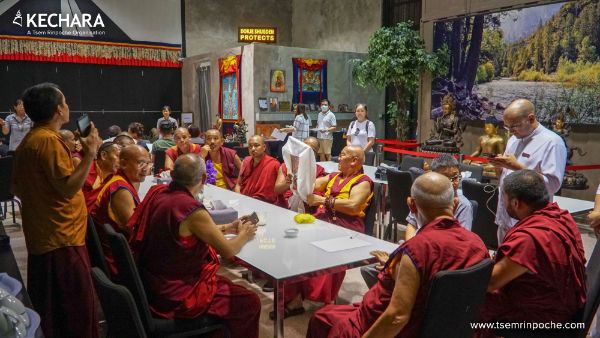
Kechara Forest Retreat was awash with a sea of maroon and saffron robes mingling with the whites and greys of Kechara pastors and members. The fragrance of sandalwood and juniper pervaded the air. A blanket of sonorous chants, tinkling of bells and drumming of damarus drifted over the open expanse of KFR.
In his parinirvana, Rinpoche had created the occasion for students and devotees to participate in virtuous work and create merit. It also revealed Kechara to be a modern yet authentic wellspring of Lama Tsongkhapa’s lineage. Though it was a lamentable time for Rinpoche’s students, it was also their finest hour, as seeds long planted and nurtured by Rinpoche blossomed into a glorious display of guru devotion.
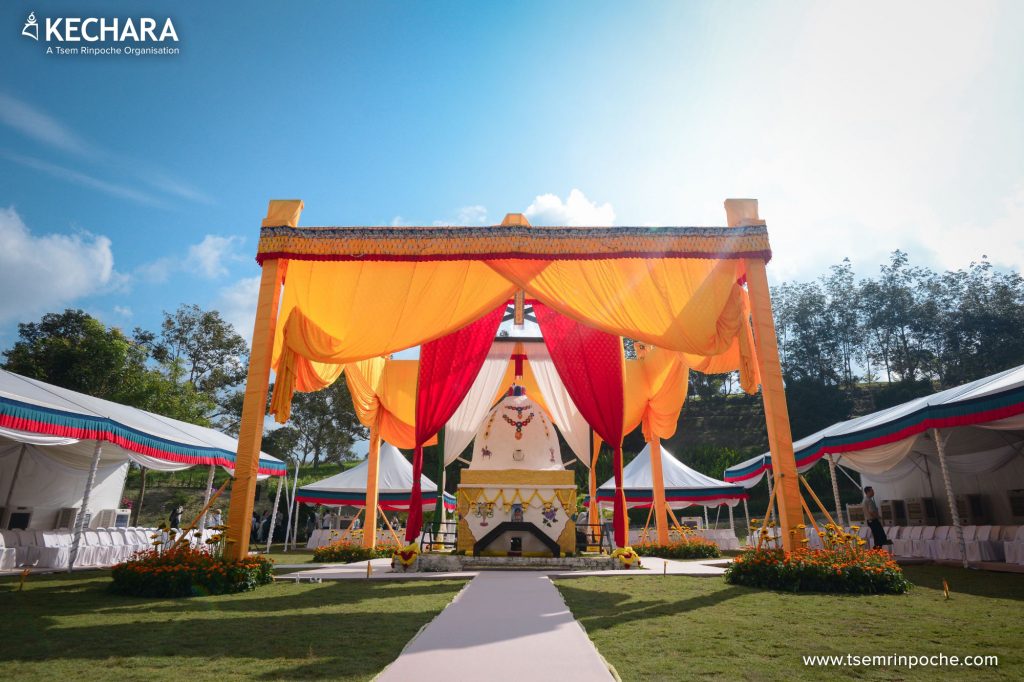
Click on image to enlarge.
By the time the high lamas and monks left Kechara, they had recognised that one of the main practices of Rinpoche’s students was Guru Devotion, the elusive foundation for spiritual attainments, and the soundest pillar that would keep Lama Tsongkhapa’s teachings high and untainted. They also remarked that Kechara had outdone itself and risen to the occasion in ways that met with the highest ideals of the Gelug tradition.
The Fire Offering
Rinpoche’s final earthly journey culminated in the king of all Tibetan Buddhist rituals — the Fire Offering of the Holy Body or kudung zhugbul.
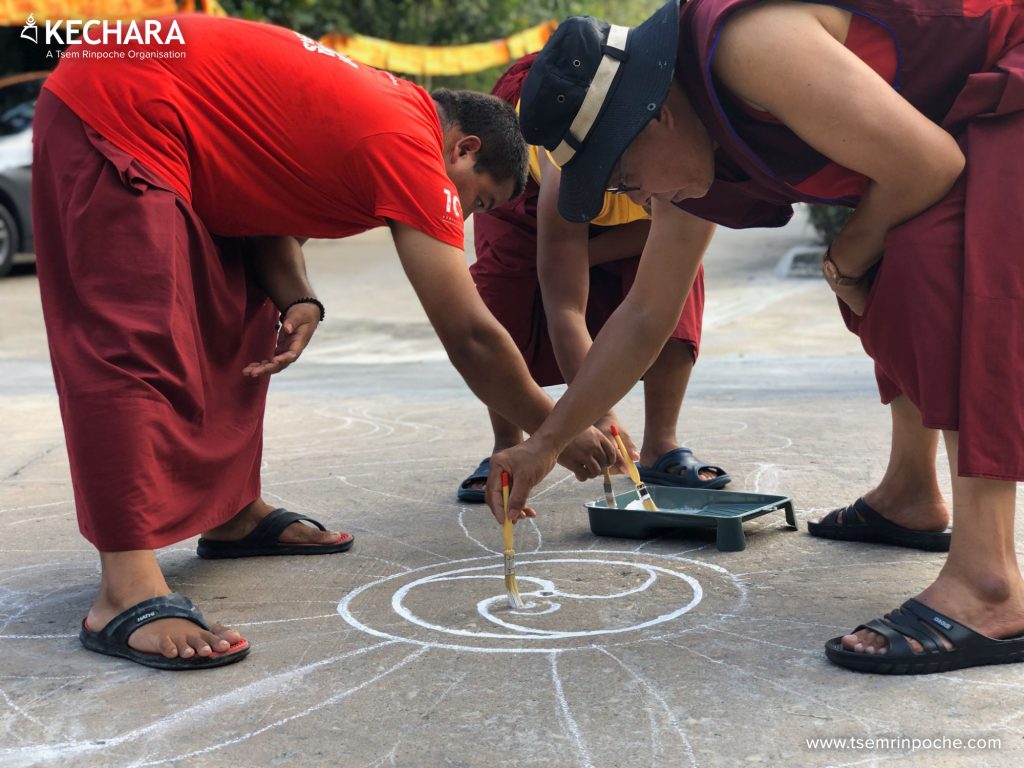
On the eve of the ceremony, the final touches were made to Rinpoche’s palanquin. The Eight Auspicious Signs were drawn on the path leading to the hallowed site. Pujas were conducted as students and devotees sought a final audience with Rinpoche’s kudung.
That night, the sound of a pair of long horns pierced the air, each deep and resonating note merging into another, summoning all corporeal and ethereal beings to assemble the following day to bear witness to the final dissolution of the 25th Tsem Rinpoche’s holy body.
Amidst clear skies on the morning of 29th September 2019, Rinpoche’s palanquin made its way to the Stupa of the Holy Body, led by H.E. Kensur Rinpoche Lobsang Phende and flanked by attendants, close students and Kechara’s pastors. Leading the retinue were the lamas, monks and sponsors while devotees and friends lined the path.
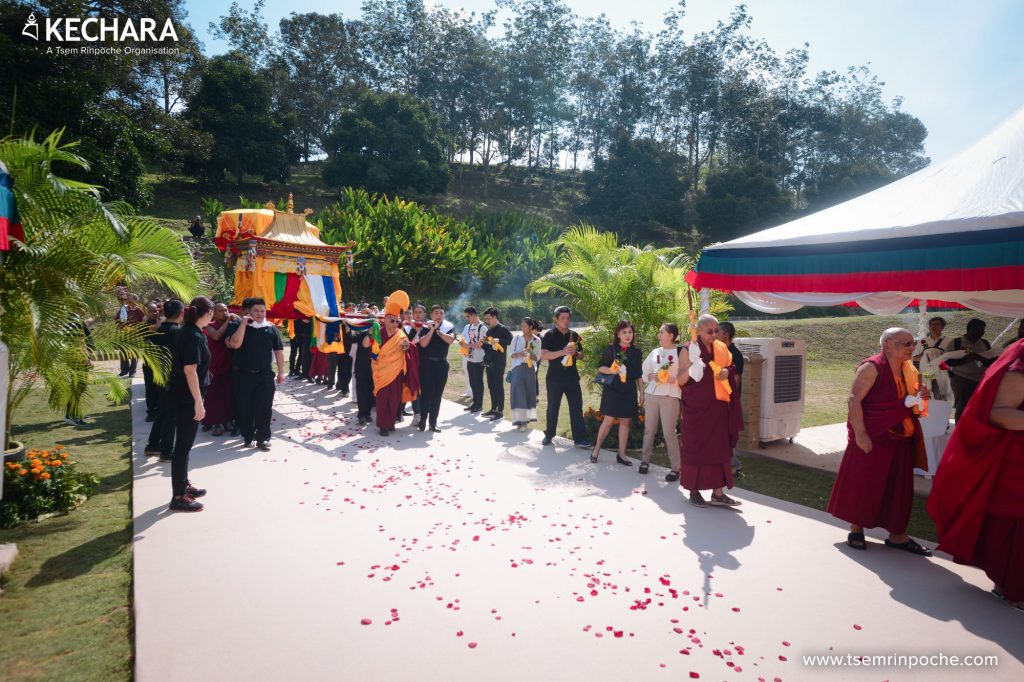
Click on image to enlarge
Upon arrival, Rinpoche’s kudung was enshrined in the Stupa with Rinpoche’s head facing the eastern direction. The Stupa was sealed and then the prayers began.
The Ceremonial Offering of the Holy Body to the Fire involved the transformation and consecration of Rinpoche’s kudung as the Buddha Vajrasattva and the Stupa as his divine mandala, or abode.
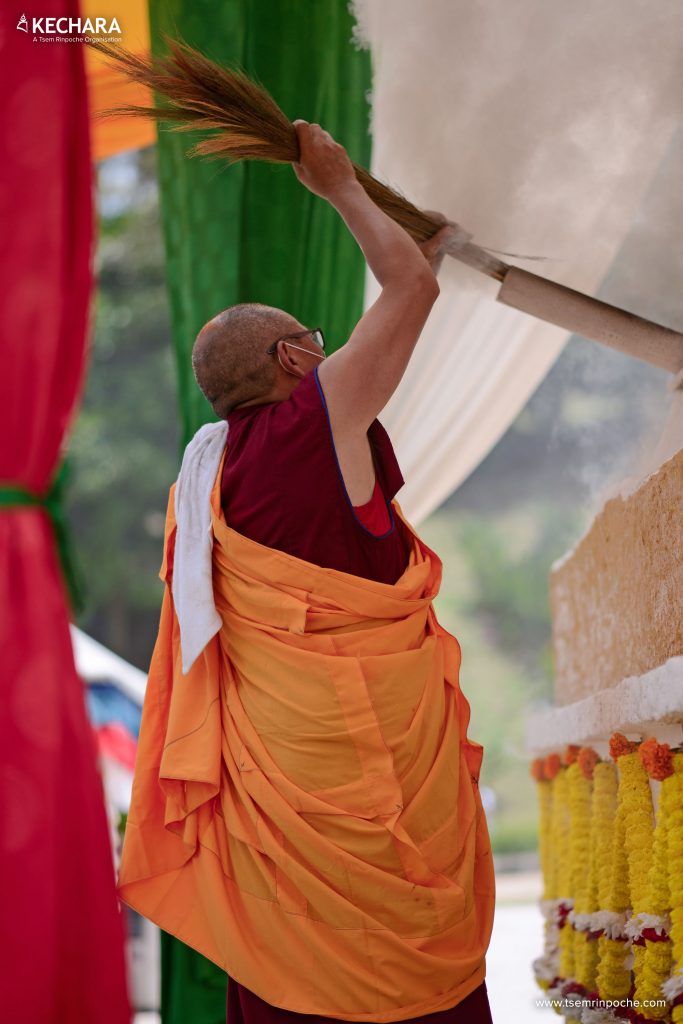
Click on image to enlarge
During the ceremony, 13 special substances were offered into the fire, each with a particular significance: sticks of wood; oil (or melted butter); black sesame seeds; durva grass; rice; tsampa (roasted barley flour); kusha grass; white mustard seeds; unhusked wheat; barley; dried peas; husked wheat; and finally puffed rice mixed with dried fruit and other ingredients. These were offered directly to Tsem Rinpoche who was one in nature with Vajrasattva, the manifestation of the purity of all the enlightened beings. As the ceremony drew to a close, Vajrasattva was bid farewell as he returned to his Pure Land. This was symbolic of Rinpoche returning to the dharmakaya.
In Tibetan Buddhism, it is believed that when a great being enters parinirvana, the gods and elementals celebrate. Some because they rejoice in the completion of an enlightened being’s work and others because they celebrate the possibility of the great being visiting their celestial realms. And they do this through manifesting auspicious omens and rainbows in the sky.
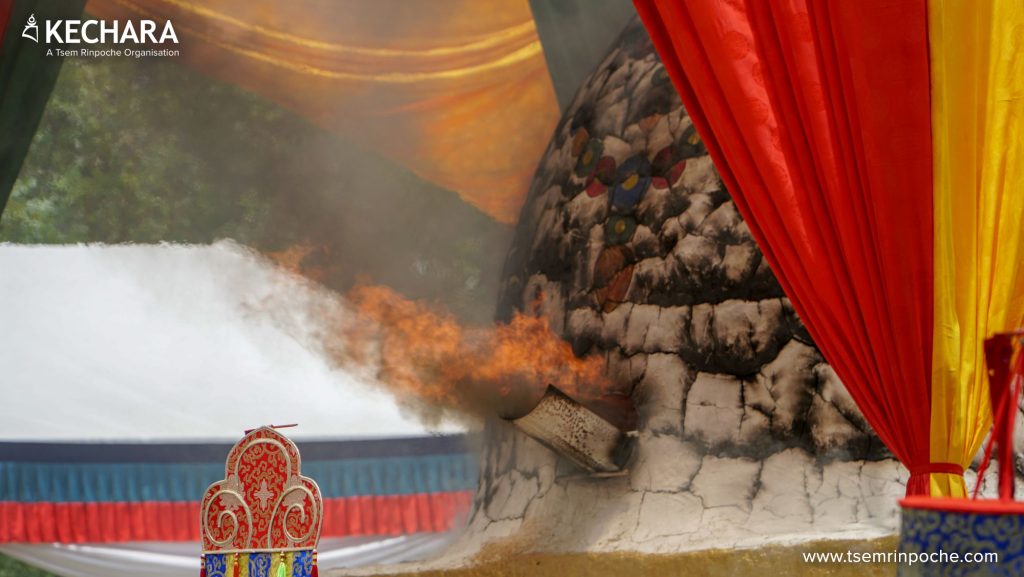
Auspicious Signs
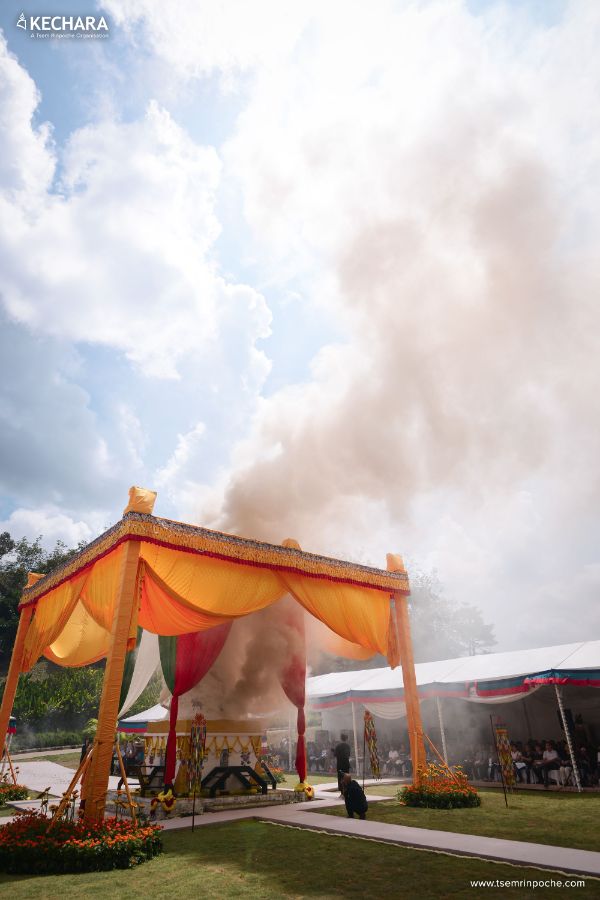
As the Fire Offering Ceremony commenced and smoke from the furnace reached for the sky, miraculous signs began to appear.
Those present witnessed the first column of smoke heading straight for the pavilion where Kensur Rinpoche and the sangha were seated. The smoke swirled around all those in robes, as though honouring the assembly of realised lamas and monks.
The second column of smoke headed to the south, a direction which could prove to be instructional in the search for Rinpoche’s reincarnation.
A third column of smoke went out to Rinpoche’s students and friends seated in two separate pavilions, enveloping all who were present in sacred embrace and bestowing the highest blessings.
Finally, a fourth column of smoke went straight towards the heavens and remained steadfast in that direction for the rest of the event.
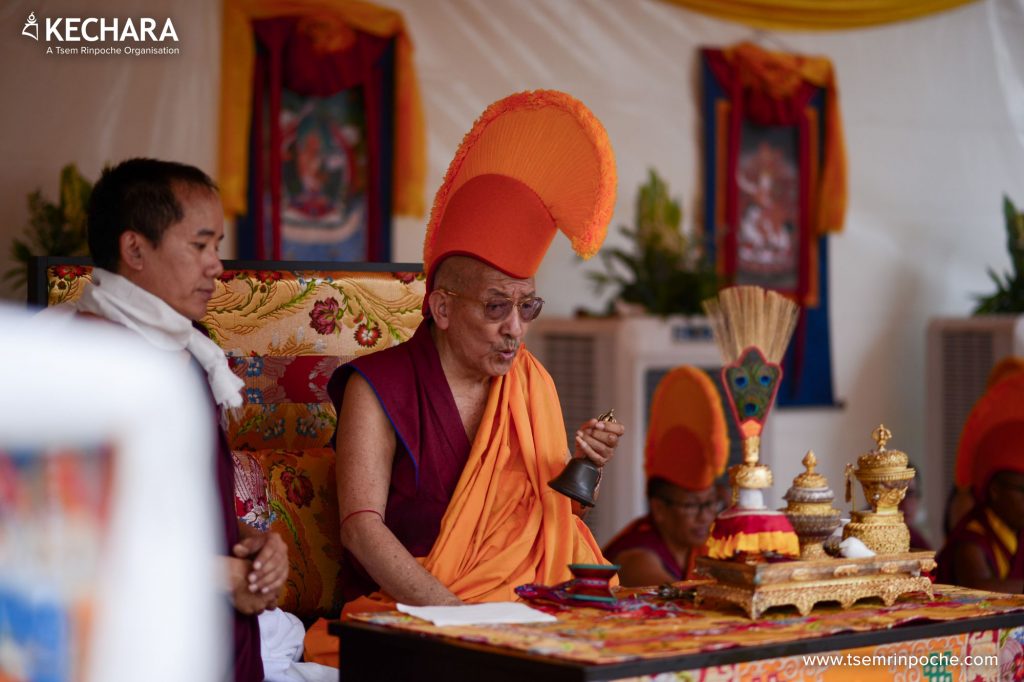
In the monks’ pavilion, a thangka of the Dharma Protector Dorje Shugden fluttered vigorously while the remaining thangkas of Buddha Shakyamuni, Lama Tsongkhapa, Manjushri and Setrap remained still.
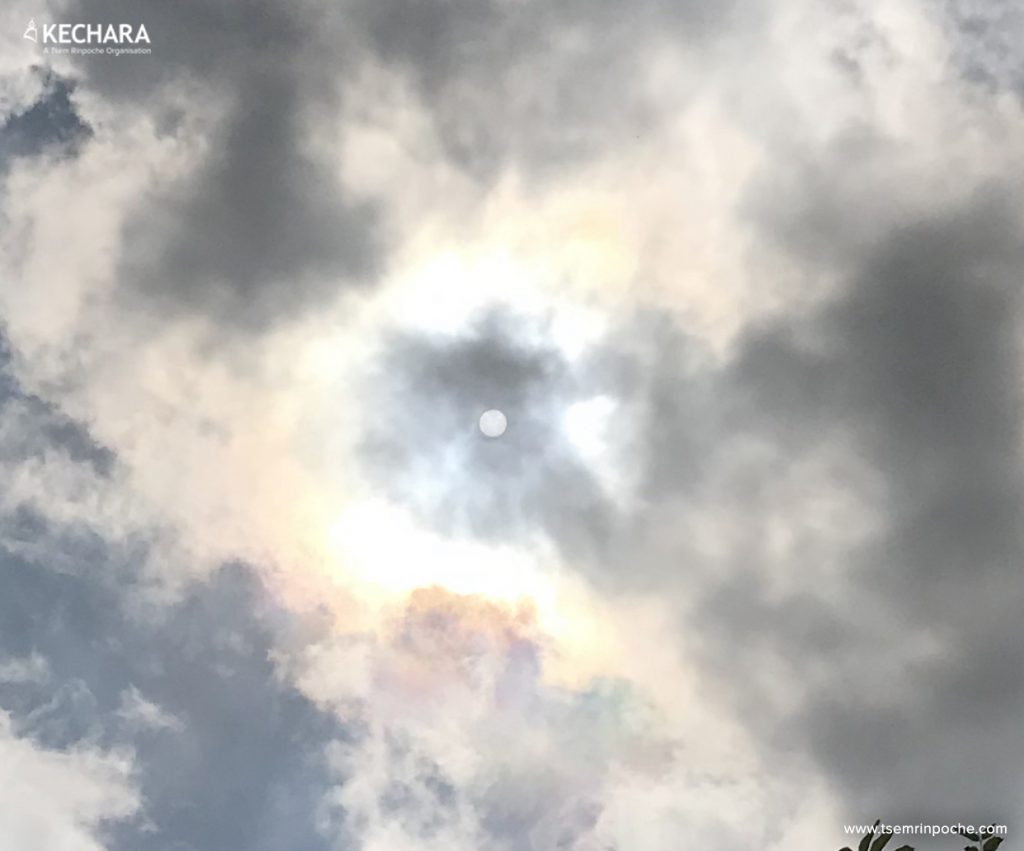
High up in the sky, a cloud appeared with an image of a Buddha in meditative equipoise. A few moments later, a rainbow halo appeared around the sun and at its centre was the silhouette of Dorje Shugden.
Thousands of miles away, a rainbow was seen arching over the grounds of Tsem Ladrang in Nepal. Another massive rainbow was witnessed over Shar Gaden Monastery in India. This rainbow remained for hours. In all three cases, the skies were clear with no rain or drizzle.
An eagle was seen circumambulating the Stupa of the Holy Body nine times. It glided away and then returned to circumambulate again. This was immensely auspicious because according to Tibetan Buddhist customs, the eagle is believed to be a mythical emanation of the primordial Buddha Vajradhara. The monks remarked that Vajradhara himself was presiding over Rinpoche’s return to the dharmakaya.
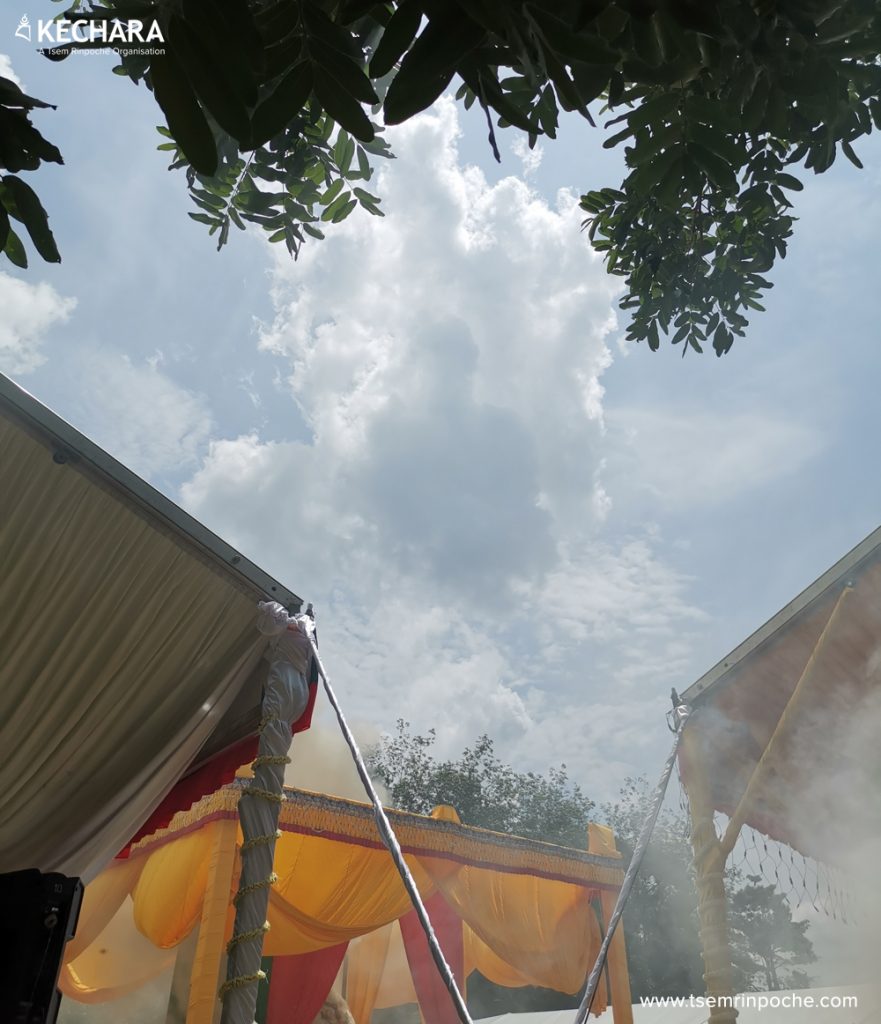
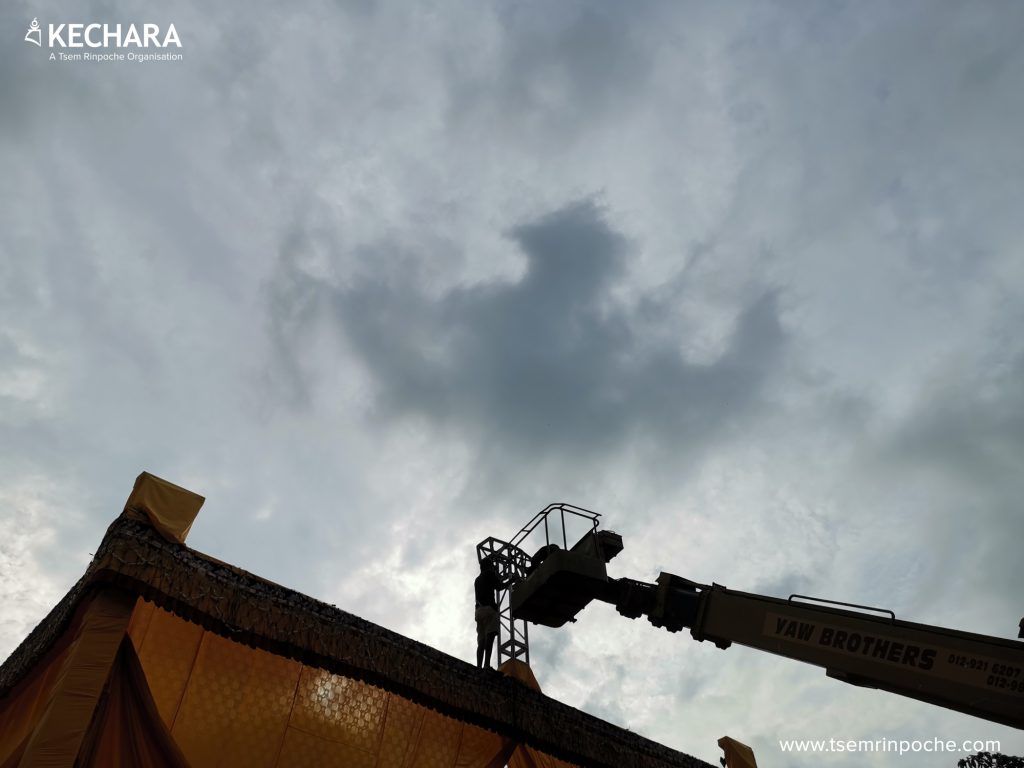
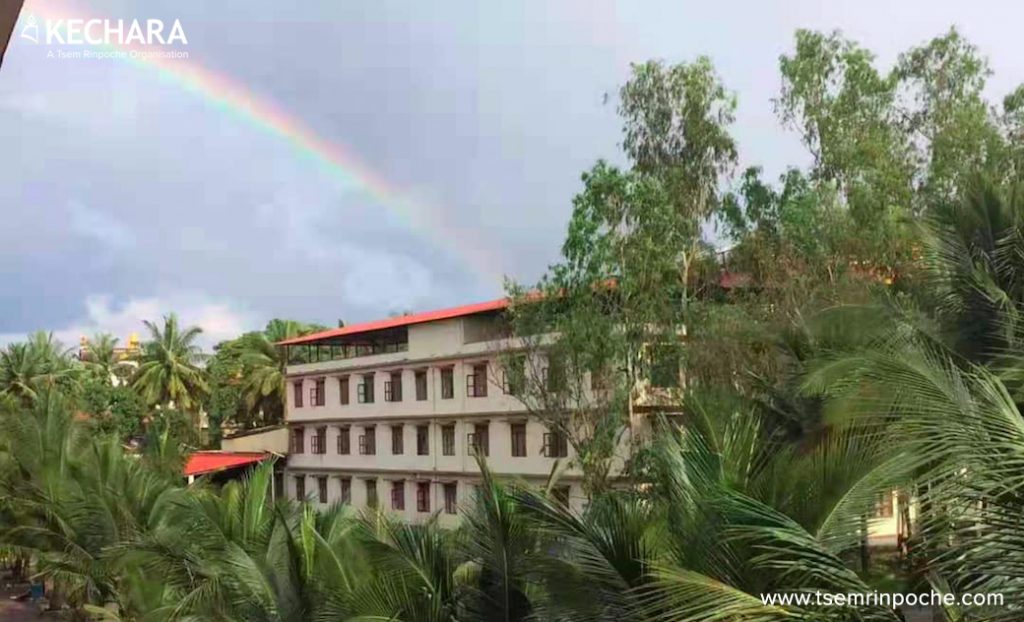
When the ritual concluded that evening, Kensur Rinpoche remarked that the entire ceremony had been conducted very well. That night, as a cool rain fell over Kechara Forest Retreat, one of Rinpoche’s close students dreamt of Heruka and Vajrayogini, and amidst sounds of monks and laypeople chanting, he heard Rinpoche laughing and saying, “Good. It went very well.”
The following morning, Rinpoche’s students woke up to even more signs. Clusters of yellow mushrooms had sprouted all around the Stupa. This would continue for several days. Later, Rinpoche’s favourite flowers were seen growing on the consecrated ground.
These signs were Rinpoche’s way of assuring his students that he would return in the future when the time is right. This is as the Buddhas and Bodhisattvas have manifested for thousands of years.
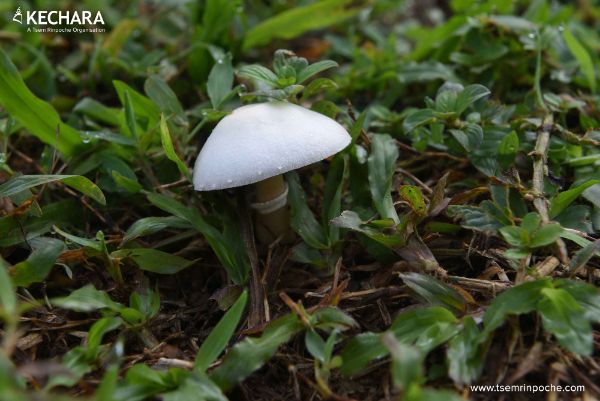
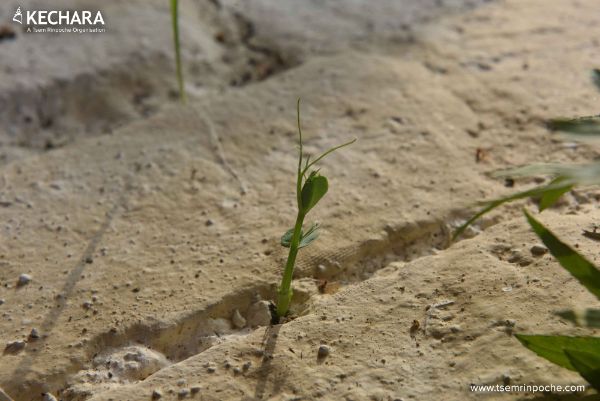
Holy Relics
The fire burned steadily for days. It was only on October 7th, 2019 that the Stupa had cooled sufficiently to be opened. As the dismantling proceeded according to tradition, the most definitive signs of Rinpoche’s spiritual realisations were revealed.
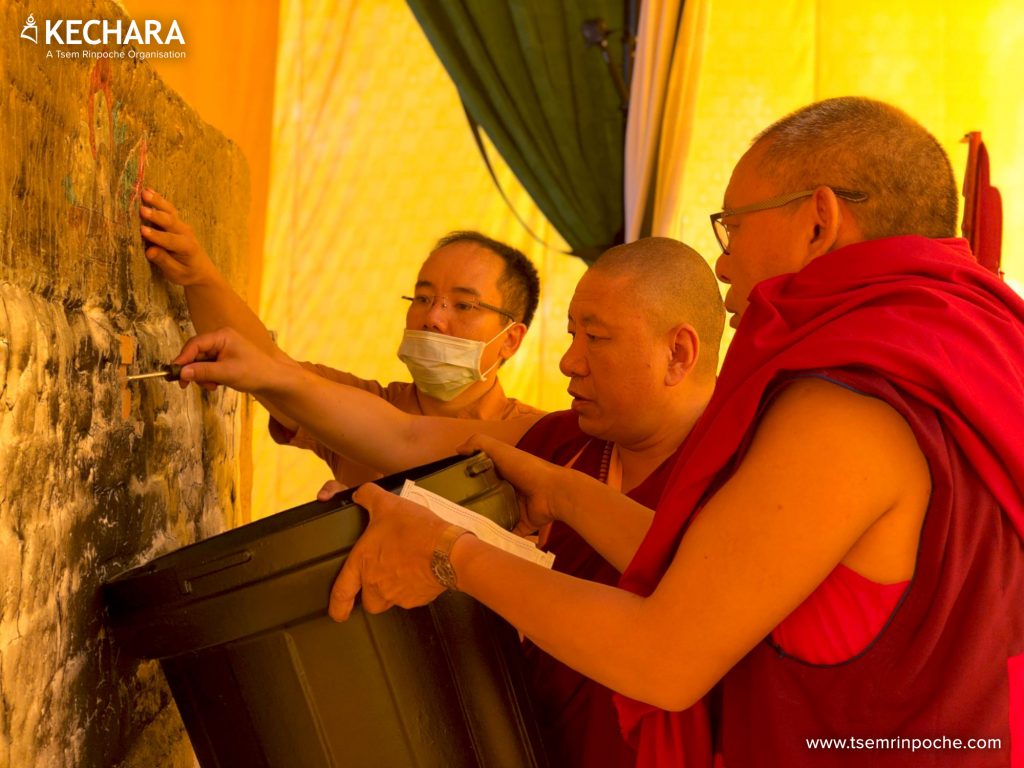
Amongst Rinpoche’s ashes and bones were literally hundreds of tiny pearl-like objects, perfectly shaped and white in colour. The lamas immediately recognised them to be precious white relic pills (ringsel in Tibetan or sariras in Sanskrit).
These white relic pills do not emanate from flesh and bone. In Tibetan Buddhism, it is said that high lamas distil their enlightened energies and transform them into these pills during cremation. The relics contain all the essence of the lama’s spiritual power and are regarded as equivalent to his living body. The sheer quantity of relics that Rinpoche left behind was a clear indication of Rinpoche’s high attainments.
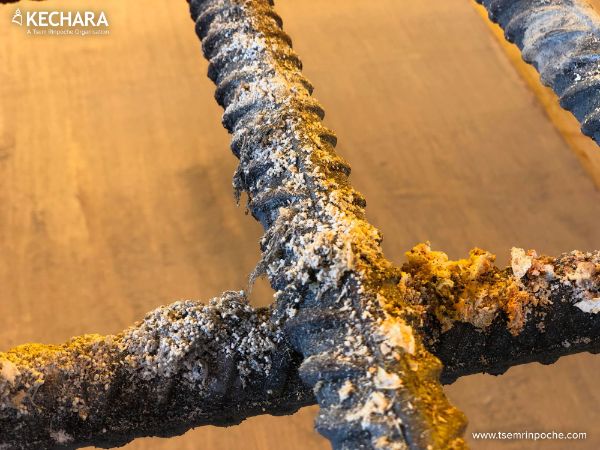
A number of Rinpoche’s teeth were also found intact and untouched by the fire. The Lord Buddha had manifested the same signs. The Buddha’s tooth relics are regarded so highly that seats of kingdoms have been moved because of them, wars fought over them, and grand palaces built to accommodate them.
Incidentally, Rinpoche’s name is derived from Tsem Monastery, with ‘tsem’ being the honorific word for ‘tooth’. The monastery was the custodian of Lama Tsongkhapa’s tooth relic, and Rinpoche was recognised by H.H. the 14th Dalai Lama and Dorje Shugden as having hailed from this monastery in one of his previous incarnations.
Rinpoche’s precious relics were temporarily enshrined in three clear stupas and his holy remains in three specially prepared vessels or bumpas adorned with tantric clothes and five-coloured silks. Later that afternoon, Rinpoche’s relics and holy remains were invited back to the Ladrang.
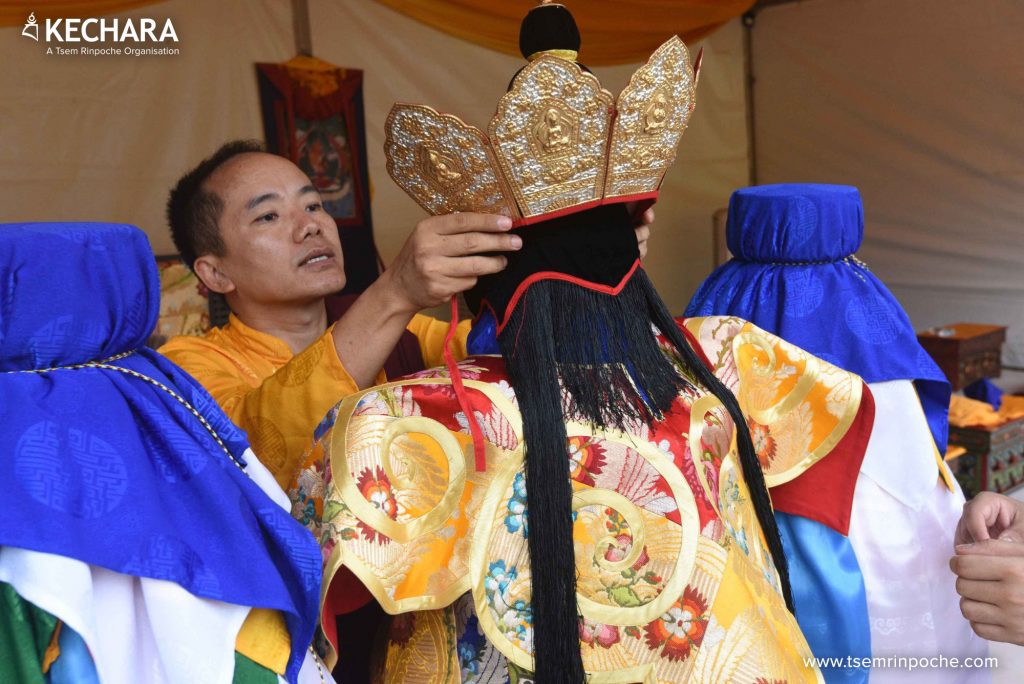
The bricks and masonry that were used to build the Stupa were also gathered and preserved. They were no longer ordinary raw materials but receptacles of a Buddha’s enlightened energy which will be used in the construction of Tsem Rinpoche’s relic stupas and incarnation chapel.
Last and most important of all, the high lamas uncovered the sand mandala at the base of the Stupa to inspect the signs Rinpoche had left behind that could aid in the search for his next incarnation. Kensur Rinpoche, Chojila and Lama Thubten Phurbu supervised the uncovering of the sand mandala and what they saw pleased them considerably.
Overhead, a light drizzle peppered through a clear sky and a pair of eagles were seen circumambulating the holy site.
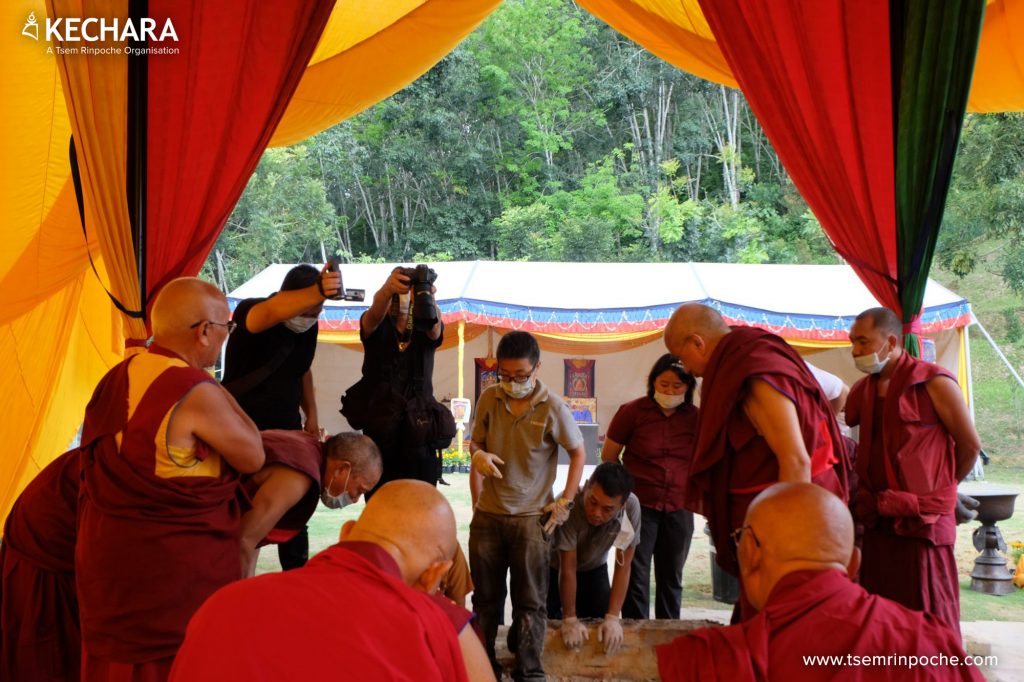
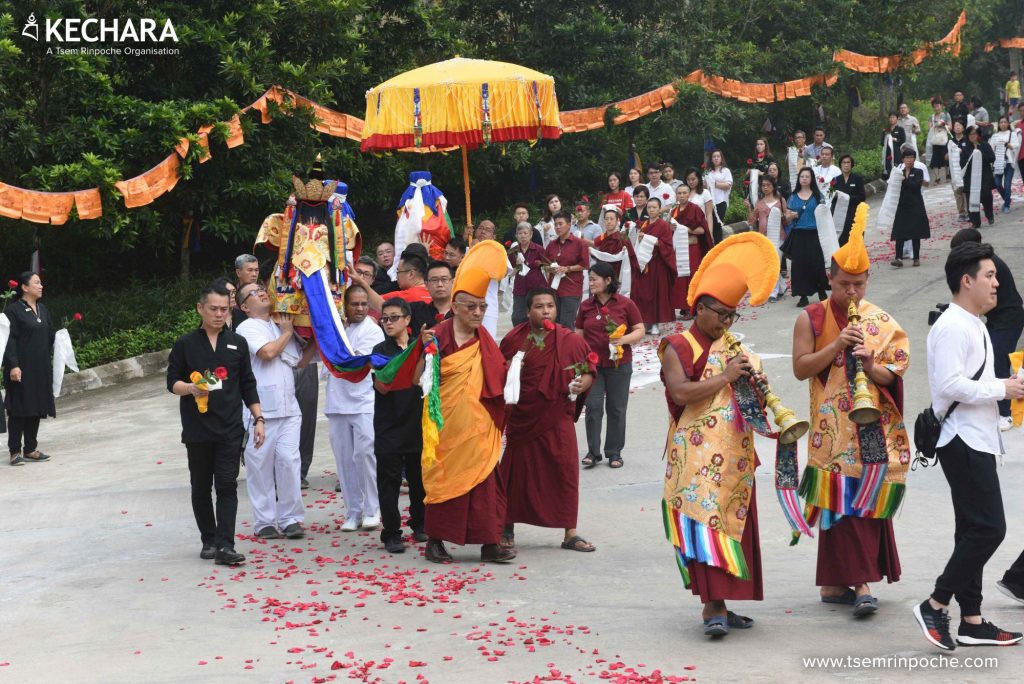
Click on image to enlarge.
A New Beginning
On the 12th of October 2019, Rinpoche’s holy relics were invited to Wisdom Hall, the main prayer hall in Kechara Forest Retreat. During this auspicious occasion, students, friends and the general public were given the opportunity to make offerings and to have audience with Rinpoche. Many who had never met Rinpoche in the flesh were able to create a karmic connection with Rinpoche then, plant the seeds to meet with his next incarnation, and thereby alter the trajectory of their future lives.
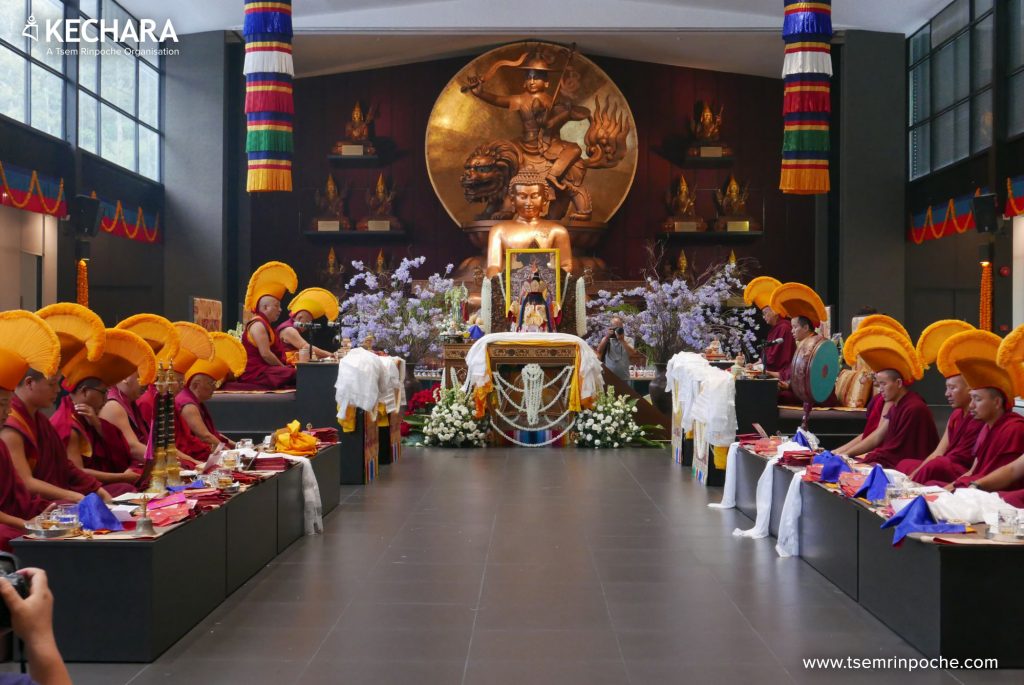
Click on image to enlarge.
With this, the play of a Mahasattva’s finest act of compassion reached its denouement. It was years in the planning and took months to enact.
Rinpoche’s manifestation of illness and eventual entry into clear light was his final act of supreme compassion. By allowing his body to be broken and eventually expire, Rinpoche absorbed the obstacles that had plagued the propagation of Lama Tsongkhapa’s pure lineage, as well as the individual and collective karmas of countless individuals. For 79 days, Rinpoche turned himself into a focal point of deep devotion and intense practice, and set the stage for devotees to create immeasurable merits. Many would emerge from this retreat, spiritually matured.
And so, even as we lament the absence of the beloved Guru, we must also recognise the tremendous blessings we have received from a Buddha who came and lived closely amongst us for a while.
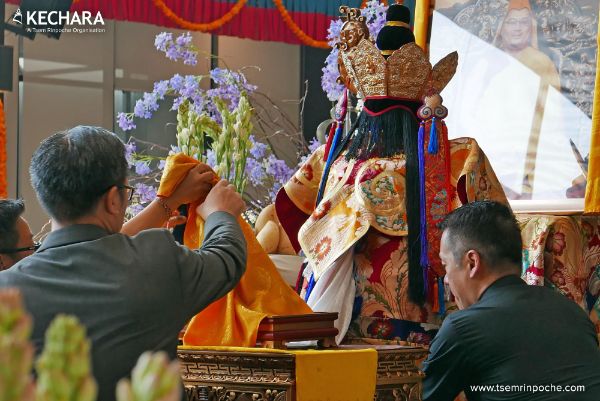
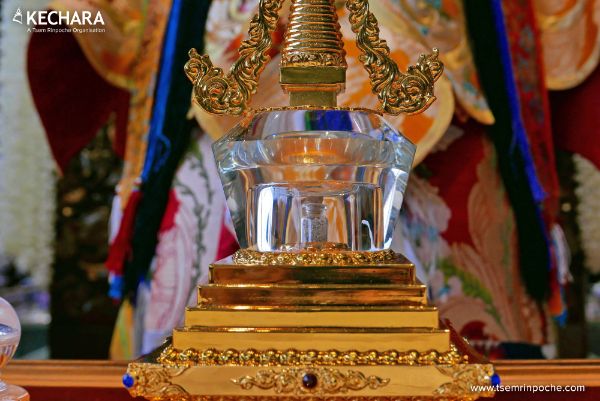
All true Buddhist practitioners are familiar with the Lord Buddha’s first teaching, The Four Noble Truths — the truth of suffering; the truth of the cause of suffering; the truth of the cessation of suffering; and the truth of the path to the cessation of suffering.
Of the Four Noble Truths, perhaps the most difficult to grasp are the third and fourth. And so a great being came in his corporeal form to articulate these teachings by example.
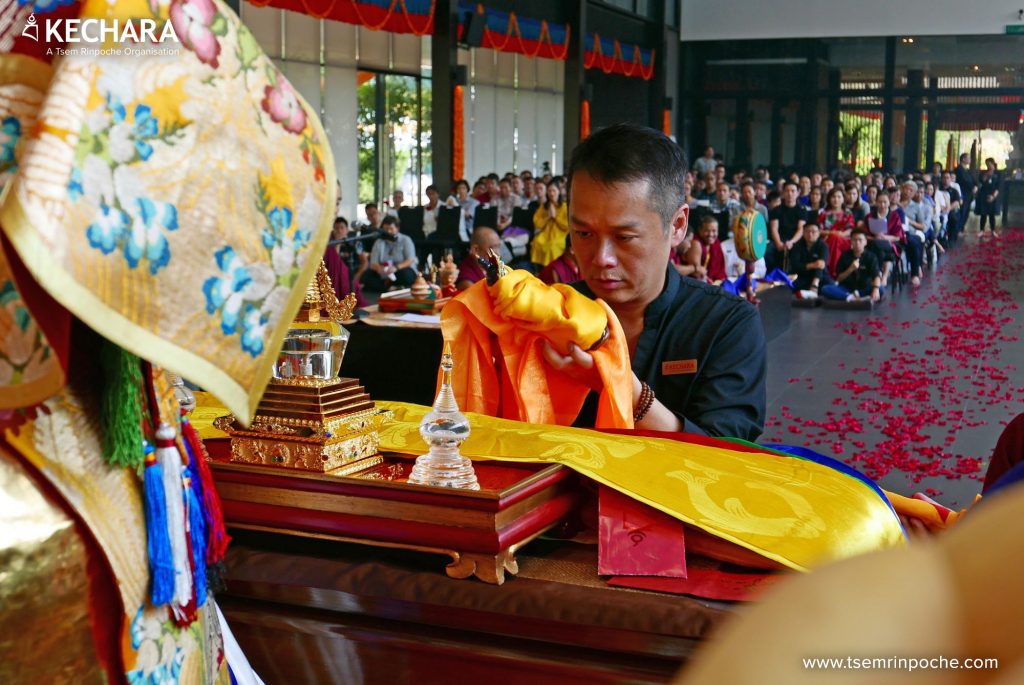
When we reflect on the life of our Guru, His Eminence the 25th Kyabje Tsem Rinpoche, we realise that our trust in the Dharma need not be based on sheer faith and fables. We can see the truth of the Buddha’s teachings in the way Rinpoche lived and in the way he passed into parinirvana.
And in bidding farewell, Rinpoche left us with a final precious lesson. Everything is impermanent — our problems are impermanent, our anguish is impermanent, our suffering is impermanent, being trapped in samsara is impermanent. Similarly, our separation from our beloved Guru is impermanent. And so, let us abide in Rinpoche’s teachings and uphold all the practices Rinpoche imparted, until we meet Rinpoche again, soon.
Before Rinpoche’s Parinirvana
Pujas performed in Kechara
- 500 candle offerings to Dorje Shugden with Kanshag (21x), Sangsol, Serkym and mantra recitation
- 500 candle offerings to Tara with recitations of A Song for the Longing of Tara the Infallible, Praises to the 21 Taras (3x) and mantra recitation
- Daily Dorje Shugden kangso with serkym, request for activities and extended mantra recitation
- Daily recitations of A Gem to Increase Life and Wisdom and extended White Tara mantra recitation
- Drukchuma (daily)
- Chasum (daily)
- Drolkar Tsedrub (daily)
- Torma Gyatsa
- Food offerings to the homeless (2500x)
- Namgyal Tsechog
- Shenyingdudog
- 4-foot White Tara Statue dedicated to Rinpoche’s long life
Pujas performed in the monasteries and by various lamas
- Drolma yuldoe gyeldo sog 3x
- Rintro gyetring dusum
- Prayer flag puja
- Shenyingdudog (3x)
- 10 White Tara statues offered to senior geshes of Shar Gaden Monastery
- Chasum
- White Tara Fire Puja
- Dorje Shugden Fire Puja
- Drugchuma and food offering to all monks of Shar Gaden Monastery
- Lutor
- Luibango
- Lentor gangmang
- Medicine Buddha puja (6x)
- Dorje Shugden puja (6x)
- Kalarupa puja (13x)
- 10,000 butterlamp offerings at Boudhanath Stupa in Nepal with 35 Confessional Buddhas recitation
- 1,000 butterlamp offerings at Vajrayogini chapels in Nepal with 35 Confessional Buddhas recitation
- 1,000 butterlamp offerings at Swayambhunath Stupa in Nepal
- Bum gyetring dusum
- Phelchen drog
- Dongpo gyenpey do gangmang
- Shiwey jinsek tongtsar
- Namgyal tsechog gangmang
- Tsedo gangmang
- Tsesung bumther
- Dukshe gangmang
- 10-day puja recitation
- Namgyal Tongchoe
- Gyabshi
- Dorje Shugden Sangsol
- Lama Chöpa Tsog
- 5,000,000 Dorje Shugden mantras and prayers performed by Lama Gangchen Rinpoche’s Dharma centres
- Various pujas done in Gonsa Monastery, Trode Khangsar, Longxi Monastery, Ninggu Monastery, Danyak Monastery, Qu Sang Monastery, Gaden Sumtseling, Longrong Monastery, Langmu Monastery, Hashul Nunnery, Nagu Monastery, Riwo Choling, Chatreng Monastery, Hongpo Monastery, Bumteng Monastery and Xiong Deng Monastery.
After Rinpoche’s Parinirvana
Pujas performed in Kechara
- 24-hour Dorje Shugden Kangso and The King of Prayers (4-19 September 2019)
- Vajrasattva Dungtrü
- Vajrasattva Dungdrub/Rudrub, daily for 49 days
- Swift Return Prayer Recitation, Dorje Shugden Kangso, light and sang offerings daily for 49 days
- Lama Chöpa Tsok, every week for seven weeks (every Tuesday)
- Vajrayogini puja and Dorje Shugden Sangsol
- Yamantaka Self-initiation, Dahkye, Chojuk and Monlam
- Vajrayogini Self-initiation, Dahkye, Chojuk and Monlam
- Lamrim and Ngarim Chenmo recitations
- Gyabshi or Four Hundred Offerings Puja
- Lhasang Smoke Offering Ritual
- Four-Faced Mahakala Kangso
- Shenyingdudog
- Manjushri Namasamgiti Recitation
- 16 Arhats Puja
- Chöd
- Four Protector Kangso (Kalarupa, Mahakala, Dorje Shugden and Setrap)
- Heruka Guru Puja
- Guhyasamaja Root Tantra Recitation
- Extensive Medicine Buddha Puja
- Bodhisattvacharyavatara Recitation
- Cittamani Tara puja
- Yangdup Puja
- 1000 Offering Drugchuma Puja
- Long Dorje Shugden Kangso
- H.E. Tsem Rinpoche’s 49th day parinirvana puja – 1000 Offering Namgyalma Ritual
- Land Blessing to consecrate the future site of Rinpoche’s Outdoor Relic Stupa
Pujas performed in the monasteries
- 1,000-offering puja to Lama Tsongkhapa (every 7th day)
- 1,000-offering puja to Medicine Buddha (every 7th day)
- 1,000-offering puja to Namgyalma (every 7th day)
- Vajrayogini Self Initiation (every 7th day)
- Yamantaka Self Initiation (every 7th day)
